Irish Americans
Irish Americans (Irish: Gael-Mheiriceánaigh)[8] are Americans who have full or partial ancestry from Ireland. About 33 million Americans — 10.1% of the total population — identified as being Irish in the 2017 American Community Survey conducted by the U.S. Census Bureau.[1] This compares with a population of 6.5 million people on the island of Ireland.
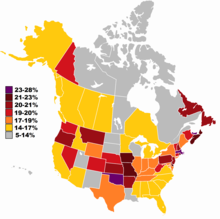 Irish Americans and Irish Canadians, % of population by state or province | |
| Total population | |
|---|---|
| Self-identified "Irish" 32,562,619[1] 10.1% of the US population (2017) | |
| Regions with significant populations | |
| Boston • New York City • Philadelphia • Baltimore • Louisville • Chicago • New England • Delaware Valley • most urban areas[2] | |
| Languages | |
| English (American English dialects); minority can speak Irish | |
| Religion | |
| Protestant (51%) • Catholic (36%) • Other (3%) • No religion (10%) (2006)[3] | |
| Related ethnic groups | |
| Anglo-Irish people • Breton Americans • Cornish Americans • English Americans • Irish Australians • Irish Canadians • Irish Catholics • Manx Americans • Scotch-Irish Americans • Scottish Americans • Scottish Canadians • Ulster Protestants • Ulster Scots people • Welsh Americans |
| Year | Number |
|---|---|
| 1980[4] | 40,165,702 |
| 1990[5] | 38,735,539 |
| 2000[6] | 30,528,492 |
| 2010[7] | 34,670,009 |
Irish immigration to the United States
17th to mid-19th century

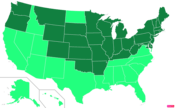


Half of the Irish immigrants to the United States in its colonial era (1607–1775) came from the Irish province of Ulster while the other half came from the other three provinces of Ireland (Leinster, Munster, and Connacht).[12] In the 17th century, immigration from Ireland to the Thirteen Colonies was minimal,[13][14] confined mostly to male indentured servants who were primarily Catholic,[14][15] and peaked with 8,000 prisoner-of-war penal transports to the Chesapeake Colonies from the Cromwellian conquest of Ireland in the 1650s (out of a total of approximately 10,000 Catholic immigrants from Ireland to the United States prior to the American Revolutionary War in 1775).[14][16][17][18] Like the entire indentured servant population in the Chesapeake Colonies at the time, 40 to 50 percent died before completing their contracts (due in large part to the Tidewater region's highly malignant disease environment), with most not establishing families and dying childless because the population of the Chesapeake Colonies, like the Thirteen Colonies in the aggregate, was not sex-balanced until the 18th century because three-quarters of the immigrants to the Chesapeake Colonies were male (and in some periods, 4:1 or 6:1 male-to-female) and fewer than 1 percent were over the age of 35. As a consequence, the population only grew due to sustained immigration rather than natural increase, and many of those who survived their indentured servitude contracts left the region.[19][20][21]
Indentured servitude in British America emerged in part due to the high cost of passage across the Atlantic Ocean,[22][23] and as a consequence, which colonies indentured servants immigrated to depended upon which colonies their patrons chose to immigrate to.[24] While the Colony of Virginia passed laws prohibiting the free exercise of Catholicism during the colonial period,[25] the General Assembly of the Province of Maryland enacted laws in 1639 protecting freedom of religion (following the instructions of a 1632 letter from Cecil Calvert, 2nd Baron Baltimore to his brother Leonard Calvert, the 1st Proprietary-Governor of Maryland), and the Maryland General Assembly later passed the 1649 Maryland Toleration Act explicitly guaranteeing those rights for Catholics.[26] In 1650, all five Catholic churches with regular services in the eight British American colonies were located in Maryland.[27] The 17th-century Maryland Catholic community had a high degree of social capital. Catholic-Protestant interdenominational marriage was not common, Catholic-Protestant intermarriages nearly always resulted in conversion to Catholicism by Protestant marital partners, and children who were born as the result of Catholic-Protestant intermarriages were nearly always raised as Catholics.[28] Additionally, 17th-century Maryland Catholics often stipulated in their wills that their children be disinherited if they renounced Catholicism.[29]
In contrast to 17th-century Maryland, the Plymouth, Massachusetts Bay and Connecticut Colonies restricted suffrage to members of the established Puritan church, while the Province of Carolina did not restrict suffrage to members of the established Anglican church. The Colony of Rhode Island and Providence Plantations had no established church, while the former New Netherland colonies (New York, New Jersey, and Delaware) also had no established church under the Duke's Laws, and the Frame of Government in William Penn's 1682 land grant established free exercise of religion for all Christians in the Province of Pennsylvania.[30][31] Following the Glorious Revolution (1688–1689), Catholics were disenfranchised in Maryland, New York, Rhode Island, Carolina, and Virginia,[30] although in Maryland, suffrage was restored in 1702.[32] In 1692, the Maryland General Assembly established the Church of England as the official state church.[33] In 1698 and 1699, Maryland, Virginia, and Carolina passed laws specifically limiting immigration of Irish Catholic indentured servants.[34] In 1700, the estimated population of Maryland was 29,600,[35] about 2,500 of which were Catholic.[36]
In the 18th century, emigration from Ireland to the Thirteen Colonies shifted from being primarily Catholic to being primarily Protestant, and with the exception of the 1790s it would remain so until the mid-to-late 1830s,[37][38] with Presbyterians constituting the absolute majority until 1835.[39][40] These Protestant immigrants were principally descended from Scottish and English tenant farmer colonists and colonial administrators who had settled the Plantations of Ireland, the largest of which was the Plantation of Ulster,[41][42][43] and these Protestant immigrants primarily migrated as families rather than as individuals.[44] In Ireland, they are referred to as the "Ulster Scots" and the "Anglo-Irish" respectively, and because the Protestant population in Ireland was and remains concentrated in Ulster and because Protestants in Northern Ireland on census reports have historically self-identified their national identity as "British" rather than "Irish" or "Northern Irish," Protestants in Ireland are collectively referred to as the "Ulster Protestants."[45]
Additionally, the Ulster Scots and Anglo-Irish intermarried to some degree,[46] and the Ulster Scots also intermarried with Huguenot refugees from the Kingdom of France following the 1685 Edict of Fontainebleau issued by Louis XIV,[47][48] and some of the Anglo-Irish settlers were actually Welsh or Manx.[49][50] However, they seldom intermarried with the Irish Catholic population in part because intermarriage between Protestants and Catholics was banned by the Penal Laws during the Protestant Ascendancy (1691–1778),[list 1] which rendered any children who were born to extralegal Catholic-Protestant intermarriages illegitimate and legally ineligible to inherit their parents' property under English law (while Presbyterian marriages were not even recognized by the state).[53] In turn, the canon law of the Catholic Church also designated Catholic-Protestant intermarriages illegitimate until Pope Pius VI extended Pope Benedict XIV's matrimonial dispensation to Ireland in 1785 for the Tametsi decree of the Council of Trent (1563),[54] and Irish Catholics almost never converted to Protestant churches during the Reformation.[55] Catholic-Protestant intermarriage would remain rare in Ireland through the early 20th century.[56]
In 1704, the Maryland General Assembly passed a law which banned the Jesuits from proselytizing, baptizing children other than those with Catholic parents, and publicly conducting Catholic Mass. Two months after its passage, the General Assembly modified the legislation to allow Mass to be privately conducted for an 18-month period, and in 1707, the General Assembly passed a law which permanently allowed Mass to be privately conducted. During this period, the General Assembly also began levying taxes on the passage of Irish Catholic indentured servants, and in 1718, the General Assembly required a religious test for voting that resumed disenfranchisement of Catholics.[57] However, lax enforcement of penal laws in Maryland (due to its population being overwhelmingly rural) enabled churches on Jesuit-operated farms and plantations to grow and become stable parishes.[58] In 1750, of the 30 Catholic churches with regular services in the Thirteen Colonies, 15 were located in Maryland, 11 in Pennsylvania, and 4 in the former New Netherland colonies.[59] By 1756, the number of Catholics in Maryland had increased to approximately 7,000,[60] which increased further to 20,000 by 1765.[58] In Pennsylvania, there were approximately 3,000 Catholics in 1756 and 6,000 by 1765 (although the large majority of the Pennsylvania Catholic population was from Germany).[58][60][61]
From 1717 to 1775, though scholarly estimates vary, the most common approximation is that 250,000 immigrants from Ireland emigrated to the Thirteen Colonies.[list 2] By the beginning of the American Revolutionary War in 1775, approximately only 2 to 3 percent of the colonial labor force was composed of indentured servants, and of those arriving from Britain from 1773 to 1776, fewer than 5 percent were from Ireland (while 85 percent remained male and 72 percent went to the Southern Colonies).[71] Immigration during the war came to a standstill except by 5,000 German mercenaries from Hesse who remained in the country following the war.[38] By the end of the war in 1783, there were approximately 24,000 to 25,000 Catholics in the United States (including 3,000 slaves) out of a total population of approximately 3 million (or less than 1 percent).[35][16][72][73] However, the majority of the Catholic population in the United States during the colonial period came from England, Germany, and France, not Ireland,[16] despite failed academic efforts by Irish historiographers to demonstrate Irish Catholics as being more numerous in the colonial period than previous scholarship had indicated.[74] By 1790, approximately 400,000 people of Irish birth or ancestry lived in the United States (or greater than 10 percent of the total population of approximately 3.9 million),[12][75] while the Catholic population grew to approximately 50,000 by 1800 (or less than 1 percent of the total population of approximately 5.3 million) due to increased Catholic emigration from Ireland during the 1790s.[38][73][76][77]
In the 18th-century Thirteen Colonies and the independent United States, while interethnic marriage among Catholics remained a dominant pattern, Catholic-Protestant intermarriage became more common (notably in the Shenandoah Valley where intermarriage among Ulster Protestants and the small number of Irish Catholics in particular was not uncommon or stigmatized),[78] and while fewer Catholic parents required that their children be disinherited in their wills if they renounced Catholicism, it remained more common among Catholic parents to do so if their children renounced their parents faith in proportion to the rest of the U.S. population.[72] Despite this, many Irish Catholics that immigrated to the United States from 1770 to 1830 converted to Baptist and Methodist churches during the Second Great Awakening (1790–1840).[79][80] In between the end of the American Revolutionary War in 1783 and the War of 1812, 100,000 immigrants came from Ulster to the United States.[81] During the French Revolutionary Wars (1792–1802) and Napoleonic Wars (1803–1815), there was a 22-year economic expansion in Ireland due to increased need for agricultural products for British soldiers and an expanding population in England. Following the conclusion of the War of the Seventh Coalition and Napoleon's exile to Saint Helena in 1815, there was a six-year international economic depression that led to plummeting grain prices and a cropland rent spike in Ireland.[39][82]
From 1815 to 1845, 500,000 more immigrants came from Ulster to the United States,[39][83] as part of a migration of approximately 1 million immigrants from Ireland from 1820 to 1845.[82] In 1820, following the Louisiana Purchase in 1804 and the Adams–Onís Treaty in 1819, the Catholic population of the United States had grown to 195,000 (or approximately 2 percent of the total population of approximately 9.6 million).[84][85] By 1840, along with resumed immigration from Germany by the 1820s,[86] the Catholic population grew to 663,000 (or approximately 4 percent out of the total population of 17.1 million).[87][88] Following the potato blight in late 1845 that initiated the Great Famine in Ireland, from 1846 to 1851, more than 1 million more Irish immigrated to the United States, 90 percent of whom were Catholic.[37][89] Many of the Famine immigrants to New York City required quarantine on Staten Island or Blackwell's Island and thousands died from typhoid fever or cholera for reasons directly or indirectly related to the Famine.[90] By 1850, following the Mexican–American War (1846–1848) that left a residual population of 80,000 Mexicans in the Southwestern United States,[91] and along with increasing immigration from Germany,[92] the Catholic population in the United States had grown to 1.6 million (or approximately 7 percent of the total population of approximately 23.2 million).[84][93] Despite the small increase in Catholic-Protestant intermarriage following the American Revolutionary War,[72] Catholic-Protestant intermarriage remained uncommon in the United States in the 19th century.[94]
Historians have characterized the etymology of the term "Scotch-Irish" as obscure,[95] and the term itself as misleading and confusing to the extent that even its usage by authors in historic works of literature about the Scotch-Irish (such as The Mind of the South by W. J. Cash) is often incorrect.[96][52][97] Historians David Hackett Fischer and James G. Leyburn note that usage of the term is unique to North American English and it is rarely used by British historians, or in Scotland or Ireland.[98][99] The first recorded usage of the term was by Elizabeth I of England in 1573 in reference to Gaelic-speaking Scottish Highlanders who crossed the Irish Sea and intermarried with the Irish Catholic natives of Ireland.[95] While Protestant immigrants from Ireland in the 18th century were more commonly identified as "Anglo-Irish," and while some preferred to self-identify as "Anglo-Irish,"[98] usage of "Scotch-Irish" in reference to Ulster Scots who immigrated to the United States in the 18th century likely became common among Episcopalians and Quakers in Pennsylvania, and records show that usage of the term with this meaning was made as early as 1757 by the Anglo-Irish philosopher Edmund Burke.[100][101]
However, multiple historians have noted that from the time of the American Revolutionary War until 1850, the term largely fell out of usage, because most Ulster Protestants self-identified as "Irish" until large waves of immigration by Irish Catholics both during and after the 1840s Great Famine in Ireland led those Ulster Protestants in America who lived in proximity to the new immigrants to change their self-identification from "Irish" to "Scotch-Irish,"[list 3] while those Ulster Protestants who did not live in proximity to Irish Catholics continued to self-identify as "Irish," or as time went on, to start self-identifying as being of "American ancestry."[104][105] While those historians note that renewed usage of "Scotch-Irish" after 1850 was motivated by anti-Catholic prejudices among Ulster Protestants,[102][103] considering the historically low rates of intermarriage between Protestants and Catholics in both Ireland and the United States,[list 4] as well as the relative frequency of interethnic and interdenominational marriage amongst Protestants in Ulster,[list 5] and the fact that not all Protestant migrants from Ireland historically were Ulster Scots,[64] James G. Leyburn argued for retaining its usage for reasons of utility and preciseness,[107] while historian Wayland F. Dunaway also argued for retention for historical precedent and linguistic description.[108]
During the colonial period, Scots-Irish settled in the southern Appalachian backcountry and in the Carolina Piedmont.[109] They became the primary cultural group in these areas, and their descendants were in the vanguard of westward movement through Virginia into Tennessee and Kentucky, and thence into Arkansas, Missouri and Texas. By the 19th century, through intermarriage with settlers of English and German ancestry, the descendants of the Scots-Irish lost their identification with Ireland. "This generation of pioneers...was a generation of Americans, not of Englishmen or Germans or Scots-Irish."[110] The two groups had little initial interaction in America, as the 18th-century Ulster immigrants were predominantly Protestant and had become settled largely in upland regions of the American interior, while the huge wave of 19th-century Catholic immigrant families settled primarily in the Northeast and Midwest port cities such as Boston, Philadelphia, New York, Buffalo, or Chicago. However, beginning in the early 19th century, many Irish migrated individually to the interior for work on large-scale infrastructure projects such as canals and, later in the century, railroads.[111]
The Scots-Irish settled mainly in the colonial "back country" of the Appalachian Mountain region, and became the prominent ethnic strain in the culture that developed there.[112] The descendants of Scots-Irish settlers had a great influence on the later culture of the Southern United States in particular and the culture of the United States in general through such contributions as American folk music, country and western music, and stock car racing, which became popular throughout the country in the late 20th century.[113]

Irish immigrants of this period participated in significant numbers in the American Revolution, leading one British major general to testify at the House of Commons that "half the rebel Continental Army were from Ireland."[114] Irish Americans signed the foundational documents of the United States—the Declaration of Independence and the Constitution—and, beginning with Andrew Jackson, served as President.
Irish Catholics in the South
In 1820 Irish-born John England became the first Catholic bishop in the mainly Protestant city of Charleston, South Carolina. During the 1820s and '30s, Bishop England defended the Catholic minority against Protestant prejudices. In 1831 and 1835, he established free schools for free African American children. Inflamed by the propaganda of the American Anti-Slavery Society, a mob raided the Charleston post office in 1835 and the next day turned its attention to England's school. England led Charleston's "Irish Volunteers" to defend the school. Soon after this, however, all schools for "free blacks" were closed in Charleston, and England acquiesced.[115]
The Irish Catholics concentrated in a few medium-sized cities, where they were highly visible, especially in Charleston, Savannah and New Orleans.[116][117] They often became precinct leaders in the Democratic Party Organizations, strongly opposed abolition of slavery, and generally favored preserving the Union in 1860, when they voted for Stephen Douglas.[118]
After secession in 1861, the Irish Catholic community supported the Confederacy and 20,000 served in the Confederate Army. Gleason says:
Support for Irish Confederate soldiers from home was vital both for encouraging them to stay in the army and to highlight to native white southerners that the entire Irish community was behind the Confederacy. Civilian leaders of the Irish and the South did embrace the Confederate national project and most became advocates of a 'hard-war' policy.[119][120]
Irish nationalist John Mitchel lived in Tennessee and Virginia during his exile from Ireland and was one of the South's most outspoken supporters during the American Civil War through his newspapers the Southern Citizen and the Richmond Enquirer.[121]
Although most began as unskilled laborers, Irish Catholics in the South achieved average or above average economic status by 1900. David T. Gleeson emphasizes how well they were accepted by society:
Native tolerance, however, was also a very important factor in Irish integration [into Southern society].... Upper-class southerners, therefore, did not object to the Irish, because Irish immigration never threatened to overwhelm their cities or states.... The Irish were willing to take on potentially high-mortality occupations, thereby sparing valuable slave property. Some employers objected not only to the cost of Irish labor but also to the rowdiness of their foreign-born employees. Nevertheless, they recognized the importance of the Irish worker to the protection of slavery.... The Catholicism practiced by Irish immigrants was of little concern to Southern natives.[122]
Mid-19th century and later
| Irish immigration to the United States (1820–1975)[12] | |||
|---|---|---|---|
| Period | Number of immigrants | Period | Number of immigrants |
| 1820–1830 | 54,338 | 1911–1920 | 146,181 |
| 1831–1840 | 207,381 | 1921–1930 | 220,591 |
| 1841–1850 | 780,719 | 1931–1940 | 13,167 |
| 1851–1860 | 914,119 | 1941–1950 | 26,967 |
| 1861–1870 | 435,778 | 1951–1960 | 57,332 |
| 1871–1880 | 436,871 | 1961–1970 | 37,461 |
| 1881–1890 | 655,482 | 1971–1975 | 6,559 |
| 1891–1900 | 388,416 | ||
| 1901–1910 | 399,065 | ||
| Total : 4,720,427 | |||
Between 1851 and 1920, 3.3 to 3.7 million Irish immigrated to the United States,[123][12] including more than 90 percent of the more than 1 million Ulster Protestant emigrants out of Ireland from 1851 to 1900.[124][89] Following the Great Famine, emigration from Ireland came primarily from Munster and Connacht,[124] while 28 percent of all immigrants from Ireland from 1851 to 1900 continued to come from Ulster. Ulster immigration continued to account for as much as 20 percent of all immigration from Ireland to the United States in the 1880s and 1890s,[89] and still accounted for 19 percent of all immigration from Ireland to the United States from 1900 to 1909 and 25 percent from 1910 to 1914.[125] The Catholic population in the United States grew to 3.1 million by 1860 (or approximately 10 percent of the total U.S. population of 31.4 million),[126][127] to 6.3 million by 1880 (or approximately 13 percent of the total U.S. population of 50.2 million),[128][129] and further to 19.8 million by 1920 (or approximately 19 percent of the total U.S. population of 106 million).[128][130]
However, due to continued immigration from Germany,[92] and beginning in the 1880s, waves of immigration from Italy, Poland, and Canada (by French Canadians) as well as from Mexico from 1900 to 1920,[131] Irish Catholics never accounted for a majority of the Catholic population in the United States through 1920.[132][133] In the 1920s, an additional 220,000 immigrants from Ireland came to the United States,[12] with emigration from Ulster falling off to 10,000 of 126,000 immigrants from Ireland (or less than 10 percent) between 1925 and 1930.[125] Following the Immigration Act of 1924 and the Great Depression,[134][135] from 1930 to 1975, only 141,000 more immigrants came from Ireland to the United States.[12] Improving economic conditions during the Post–World War II economic expansion and the passage of the restrictive Immigration and Nationality Act of 1965 contributed to the decline in mass immigration from Ireland.[135] Due to the early 1980s recession, 360,000 Irish emigrated out of the country, with the majority going to England and many to the United States (including approximately 40,000 to 150,000 on overstayed travel visas as undocumented aliens).[136]
Beginning in the 1970s, surveys of self-identified Irish Americans found that consistent majorities of Irish Americans also self-identified as being Protestant.[137][138] While there was a greater total number of immigrants after immigration from Ireland transitioned to being primarily Catholic in the mid-to-late 1830s,[37][44][39][40] fertility rates in the United States were lower from 1840 to 1970 after immigration from Ireland became primarily Catholic than they were from 1700 to 1840 when immigration was primarily Protestant.[139][140][141] Also, while Irish immigrants to the United States in the early 20th century had higher fertility rates than the U.S. population as a whole, they had lower fertility rates than German immigrants to the United States during the same time period and lower fertility rates than the contemporaneous population of Ireland, and subsequent generations had lower fertility rates than the emigrant generation.[142] This is due to the fact that despite coming from the rural regions of an agrarian society, Irish immigrants in the post-Famine migration generally immigrated to the urban areas of the United States because by 1850 the costs of moving to a rural area and establishing a farm was beyond the financial means of most Irish immigrants.[143]
Despite Catholic-Protestant intermarriage becoming more common in the 20th century than the 19th century,[94] and interfaith marriage in the United States becoming more common beginning in the 1960s, changes in interdenominational marriage among Christians has remained largely flat during the same time period and the Catholic population has had the highest secularization rate of any Christian denomination in the United States (followed by Mainline Protestants but at one-fourth of the Catholic leaving-to-joining ratio).[144][145] In the 1990s, the Irish economy began to boom again, and by the turn of the 21st century, immigration to Ireland from the United States began to consistently exceed immigration from Ireland to the United States.[146]
Irish immigration had greatly increased beginning in the 1830s due to the need for unskilled labor in canal building, lumbering, and construction works in the Northeast.[147] The large Erie Canal project was one such example where Irishmen were many of the laborers. Small but tight communities developed in growing cities such as Philadelphia, Boston, and New York.

From 1820 to 1860, 1,956,557 Irish arrived, 75% of these after the Great Irish Famine (or The Great Hunger, Irish: An Gorta Mór) of 1845–1852, struck.[148] According to a 2019 study, "the sons of farmers and illiterate men were more likely to emigrate than their literate and skilled counterparts. Emigration rates were highest in poorer farming communities with stronger migrant networks."[149]
Of the total Irish immigrants to the U.S. from 1820 to 1860, many died crossing the ocean due to disease and dismal conditions of what became known as coffin ships.[147]
Most Irish immigrants to the United States during this period favored large cities because they could create their own communities for support and protection in a new environment.[150] Cities with large numbers of Irish immigrants included Boston, Philadelphia, and New York, as well as Pittsburgh, Baltimore, Detroit, Chicago, Cleveland, St. Louis, St. Paul, San Francisco, and Los Angeles.
.jpg)
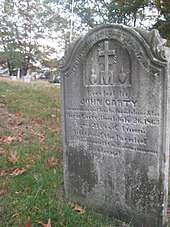
While many Irish did stay near large cities, countless others were part of westward expansion. They were enticed by tales of gold, and by the increasing opportunities for work and land. In 1854, the government opened Kansas Territory to settlers.[151] While many people in general moved to take advantage of the unsettled land, Irish were an important part. Many Irish men were physical laborers. In order to civilize the west, many strong men were needed to build the towns and cities. Kansas City was one city that was built by Irish immigrants.[151] Much of its population today is of Irish descent. Another reason for Irish migration west was the expansion of railroads. Railway work was a common occupation among immigrant men because workers were in such high demand. Many Irish men followed the expansion of railroads, and ended up settling in places that they built in.[152] Since the Irish were a large part of those Americans moving west, much of their culture can still be found today.
Civil War through the early 20th century
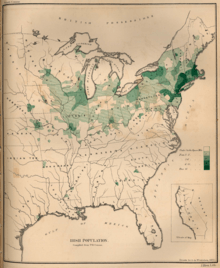
During the American Civil War, Irish Americans volunteered for the Union Army in high numbers, and at least 38 Union regiments had the word "Irish" in their titles. 144,221 Union soldiers were born in Ireland; additionally, perhaps an equal number of Union soldiers were of Irish descent.[153] Many immigrant soldiers formed their own regiments, such as the Irish Brigade.[154][155][156]
General John McCausland was a notable brigadier general in the Confederate States Army during the Civil War. He was the son of an Irish immigrant.
However, conscription was resisted by many Irish as an imposition.[155][156] Two years into the war, the conscription law was passed in 1863, and major draft riots erupted in New York. It coincided with the efforts of the city's dominant political machine, Tammany Hall, to enroll Irish immigrants as citizens so they could vote in local elections.[157] Many such immigrants suddenly discovered they were now expected to fight for their new country.[158] The Irish, employed primarily as laborers, were usually unable to afford the $300 "commutation fee" to procure a replacement for service.[159] Many of the Irish viewed blacks as competition for scarce jobs, and as the reason why the Civil War was being fought.[160] African Americans who fell into the mob's hands were often beaten or killed.[161][162] The Colored Orphan Asylum on Fifth Avenue, which provided shelter for hundreds of children, was attacked by a mob. It was seen as a "symbol of white charity to blacks and of black upward mobility," reasons enough for its destruction at the hands of a predominantly Irish mob which looked upon African Americans as direct social and economic competitors.[163] Fortunately, the largely Irish-American police force was able to secure the orphanage for enough time to allow orphans to escape.[161][164]
In the Confederacy, many Irish were initially reluctant to support secession; most of them voted for Stephen Douglas in the 1860 presidential election. However several bishops were enthusiastic supporters of the Confederacy, and the Irish volunteered for service. Gleeson wrote that they had higher desertion rates than non-Irish, and sometimes switched sides, suggesting that their support for the Confederacy was tepid.[165] During Reconstruction, however, they took a strong position in favor of white supremacy, and they played major roles in attacking blacks in riots in Memphis and New Orleans.[166][167][168]
In 1871, New York's Orange Riots broke out when Irish Protestants celebrated the British victory at the Battle of the Boyne by parading through Irish Catholic neighborhoods, taunting the residents who then responded with violence. Police Superintendent James J. Kelso, a Protestant, ordered the parade cancelled as a threat to public safety. Kelso was overruled by the governor, who ordered 5000 militia to protect the marchers.[169] The Catholics attacked but were stopped by the militia and police, who opened fire killing about 63 Catholics.[170]

Relations between the U.S. and Britain were chilly during the 1860s as Americans resented British and Canadian support for the Confederacy during the Civil War. After the war American authorities looked the other way as Irish Catholic "Fenians" plotted and even attempted an invasion of Canada.[171] The Fenians proved a failure, but Irish Catholic politicians, a growing power in the Democratic Party, demanded more independence for Ireland and made anti-British rhetoric—called "twisting the lion's tail"—a staple of election campaign appeals to the Irish Catholic vote.[172]
.jpg)
A second wave of post-famine Irish immigration, resulting largely from a changing rural economy and the lure of high-paying jobs in America, continued from 1855 to 1921, when the Emergency Immigration Acts of 1921 and 1924 imposed a "quota system" that significantly limited immigration. These later immigrants mostly settled in industrial towns and cities of the Northeast and Midwest where Irish American neighborhoods had previously been established.[173][174]
The Irish were having a huge impact on America as a whole. In 1910, there were more people in New York City of Irish ancestry than Dublin's whole population, and even today, many of these cities still retain a substantial Irish-American community.[175] Mill towns such as Lawrence, Lowell, and Pawtucket attracted many single Irish women as workers in particular. The anthracite Coal Region of northeastern Pennsylvania saw a massive influx of Irish during this time period; abuses by owners eventually gave rise to resistance groups such as the Molly Maguires. The best urban economic opportunities for unskilled Irish women and men included "factory and millwork, domestic service, and the physical labor of public work projects."[176]
During the mid-1900s, Irish immigration to the United States began to decrease. During the years of 1941–1950 there were only 1,000,000 immigrants in total, and only 68,151 of them came from Ireland. These immigrants from Ireland were coming to the U.S. for the same reasons as those before them; they came looking for jobs.[177]
Social history in the United States
Religion and society
Religion has been important to the Irish American identity in America, and continues to play a major role in their communities. Surveys conducted since the 1970s have shown consistent majorities or pluralities of those who self-identify as being of Irish ancestry in the United States as also self-identifying as Protestants.[137][138] The Protestants' ancestors arrived primarily in the colonial era, while Catholics are primarily descended from immigrants of the 19th century. Irish leaders have been prominent in the Catholic Church in the United States for over 150 years. The Irish have been leaders in the Presbyterian and Methodist traditions, as well.[178]
Surveys in the 1990s show that of Americans who identify themselves as "Irish", 51% said they were Protestant and 36% identified as Catholic. In the South, Protestants account for 73% of those claiming Irish origins, while Catholics account for 19%. In the North, 45% of those claiming Irish origin are Catholic, while 39% are Protestant.[178] Many African Americans and Native Americans claim Irish Protestant or Scots-Irish ancestry.[179]
Irish Catholic and Ulster Protestant relations
Between 1607 and 1820, the majority of emigrants from Ireland to America were Protestants[180] who were described simply as "Irish".[181] The religious distinction became important after 1820,[182] when large numbers of Irish Catholics began to emigrate to the United States. Some of the descendants of the colonial Irish Protestant settlers from Ulster began thereafter to redefine themselves as "Scotch Irish", to stress their historic origins, and distanced themselves from Irish Catholics;[183] others continued to call themselves Irish, especially in areas of the South which saw little Irish Catholic immigration. By 1830, Irish diaspora demographics had changed rapidly, with over 60% of all Irish settlers in the US being Catholics from rural areas of Ireland.[184]
Some Protestant Irish immigrants became active in explicitly anti-Catholic organizations such as the Orange Institution and the American Protective Association. However, participation in the Orange Institution was never as large in the United States as it was in Canada.[185] In the early nineteenth century, the post-Revolutionary republican spirit of the new United States attracted exiled United Irishmen such as Theobald Wolf Tone and others, with the presidency of Andrew Jackson exemplifying this attitude.[186] Most Protestant Irish immigrants in the first several decades of the nineteenth century were those who held to the republicanism of the 1790s, and who were unable to accept Orangeism. Loyalists and Orangemen made up a minority of Irish Protestant immigrants to the United States during this period. Most of the Irish loyalist emigration was bound for Upper Canada and the Canadian Maritime provinces, where Orange lodges were able to flourish under the British flag.[185]
By 1870, when there were about 930 Orange lodges in the Canadian province of Ontario, there were only 43 in the entire eastern United States. These few American lodges were founded by newly arriving Protestant Irish immigrants in coastal cities such as Philadelphia and New York.[187] These ventures were short-lived and of limited political and social impact, although there were specific instances of violence involving Orangemen between Catholic and Protestant Irish immigrants, such as the Orange Riots in New York City in 1824, 1870 and 1871.[188]
The first "Orange riot" on record was in 1824, in Abingdon Square, New York, resulting from a 12 July march. Several Orangemen were arrested and found guilty of inciting the riot. According to the State prosecutor in the court record, "the Orange celebration was until then unknown in the country." The immigrants involved were admonished: "In the United States the oppressed of all nations find an asylum, and all that is asked in return is that they become law-abiding citizens. Orangemen, Ribbonmen, and United Irishmen are alike unknown. They are all entitled to protection by the laws of the country."[189]

The later Orange Riots of 1870 and 1871 killed nearly 70 people, and were fought out between Irish Protestant and Catholic immigrants. After this the activities of the Orange Order were banned for a time, the Order dissolved, and most members joined Masonic orders. After 1871, there were no more riots between Irish Catholics and Protestants.[190]
America offered a new beginning, and "...most descendents of the Ulster Presbyterians of the eighteenth century and even many new Protestant Irish immigrants turned their backs on all associations with Ireland and melted into the American Protestant mainstream."[191]
Catholics
Irish priests (especially Dominicans, Franciscans, Augustinians and Capuchins) came to the large cities of the East in the 1790s, and when new dioceses were erected in 1808 the first bishop of New York was an Irishman in recognition of the contribution of the early Irish clergy.[192]
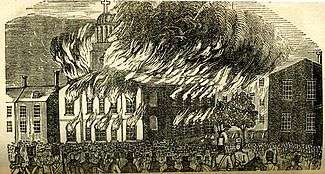
Saint Patrick's Battalion (San Patricios) was a group of several hundred immigrant soldiers, the majority Irish, who deserted the U.S. Army during the Mexican–American War because of ill treatment or sympathetic leanings to fellow Mexican Catholics. They joined the Mexican army.[193]
In Boston between 1810 and 1840 there had been serious tensions between the bishop and the laity who wanted to control the local parishes. By 1845, the Catholic population in Boston had increased to 30,000 from around 5,000 in 1825, due to the influx of Irish immigrants. With the appointment of John B. Fitzpatrick as bishop in 1845, tensions subsided as the increasingly Irish Catholic community grew to support Fitzpatrick's assertion of the bishop's control of parish government.[194]

In New York, Archbishop John Hughes (1797–1864), an Irish immigrant himself, was deeply involved in "the Irish question"—Irish independence from British rule. Hughes supported Daniel O'Connell's Catholic emancipation movement in Ireland, but rejected such radical and violent societies as the Young Irelanders and the National Brotherhood. Hughes also disapproved of American Irish radical fringe groups, urging immigrants to assimilate themselves into American life while remaining patriotic to Ireland "only individually".[195] In Hughes's view, a large-scale movement to form Irish settlements in the western United States was too isolationist and ultimately detrimental to immigrants' success in the New World.[196]
In the 1840s, Hughes crusaded for public-funded Irish Schools modeled after the successful Irish public school system in Lowell, Massachusetts. Hughes denounced the Public School Society of New York as an extension of an Old-World struggle whose outcome was directed not by understanding of the basic problems but, rather, by mutual mistrust and violently inflamed emotions. For Irish Catholics, the motivation lay largely in memory of British oppression, while their antagonists were dominated by the English Protestant historic fear of papal interference in civil affairs. Because of the vehemence of this quarrel, the New York Legislature passed the Maclay Act in 1842, giving New York City an elective Board of Education empowered to build and supervise schools and distribute the education fund—but with the proviso that none of the money should go to schools which taught religion. Hughes responded by building an elaborate parochial school system that stretched to the college level, setting a policy followed in other large cities. Efforts to get city or state funding failed because of vehement Protestant opposition to a system that rivaled the public schools.[197]
In the west, Catholic Irish were having a large effect as well. The open west attracted many Irish immigrants. Many of these immigrants were Catholic. When they migrated west, they would form "little pockets" with other Irish immigrants.[151] Irish Catholic communities were made in "supportive, village style neighborhoods centered around a Catholic church and called 'parishes'".[151] These neighborhoods affected the overall lifestyle and atmosphere of the communities. Other ways religion played a part in these towns was the fact that many were started by Irish Catholic priests. Father Bernard Donnelly started "Town of Kansas" which would later become Kansas City. His influence over early stages Kansas City was great, and so the Catholic religion was spread to other settlers who arrived.[151] While not all settlers became Catholics, a great number of the early settlers were Catholic. In other western communities, Irish priests wanted to convert the Native Americans to Catholicism.[151] These Catholic Irish would contribute not only to the growth of Catholic population in America, but to the values and traditions in America.

Jesuits established a network of colleges in major cities, including Boston College, Fordham University in New York, and Georgetown University in Washington, D.C. Fordham was founded in 1841 and attracted students from other regions of the United States, and even South America and the Caribbean. At first exclusively a liberal arts institution, it built a science building in 1886, lending more legitimacy to science in the curriculum there. In addition, a three-year bachelor of science degree was created.[198] Boston College, by contrast, was established over twenty years later in 1863 to appeal to urban Irish Catholics. It offered a rather limited intellectual curriculum, however, with the priests at Boston College prioritizing spiritual and sacramental activities over intellectual pursuits. One consequence was that Harvard Law School would not admit Boston College graduates to its law school. Modern Jesuit leadership in American academia was not to become their hallmark across all institutions until the 20th century.[199]
The Irish became prominent in the leadership of the Catholic Church in the U.S. by the 1850s—by 1890 there were 7.3 million Catholics in the U.S. and growing, and most bishops were Irish.[200] As late as the 1970s, when Irish were 17% of American Catholics, they were 35% of the priests and 50% of the bishops, together with a similar proportion of presidents of Catholic colleges and hospitals.[201]
Protestants
The Scots-Irish who settled in the back country of colonial America were largely Presbyterians.[202] The establishment of many settlements in the remote back-country put a strain on the ability of the Presbyterian Church to meet the new demand for qualified, college-educated clergy.[203] Religious groups such as the Baptists and Methodists did not require higher education of their ministers, so they could more readily supply ministers to meet the demand of the growing Scots-Irish settlements.[203] By about 1810, Baptist and Methodist churches were in the majority, and the descendants of the Scotch-Irish today remain predominantly Baptist or Methodist.[204] They were avid participants in the revivals taking place during the Great Awakening from the 1740s to the 1840s.[205] They take pride in their Irish heritage because they identify with the values ascribed to the Scotch-Irish who played a major role in the American Revolution and in the development of American culture.[178]
Presbyterians
The first Presbyterian community in America was established in 1640 in Southampton, Long Island New York.[206] Francis Makemie, an Irish Presbyterian immigrant later established churches in Maryland and Virginia.[207] Makemie was born and raised near Ramelton, County Donegal, to Ulster Scots parents. He was educated in the University of Glasgow and set out to organize and initiate the construction of several Presbyterian Churches throughout Maryland and Virginia. By 1706, Makemie and his followers constructed a Presbyterian Church in Rehobeth, Maryland.[208][209] In 1707, after traveling to New York to establish a presbytery, Francis Makemie was charged with preaching without a license by the English immigrant and Governor of New York, Edward Hyde.[210] Makemie won a vital victory for the fight of religious freedom for Scots-Irish immigrants when he was acquitted and gained recognition for having "stood up to Anglican authorities". Makemie became one of the wealthiest immigrants to colonial America, owning more than 5,000 acres and 33 slaves.[211][212]
New Light Presbyterians founded the College of New Jersey, later renamed Princeton University, in 1746 in order to train ministers dedicated to their views. The college was the educational and religious capital of Scots-Irish America.[213] By 1808, loss of confidence in the college within the Presbyterian Church led to the establishment of the separate Princeton Theological Seminary, but deep Presbyterian influence at the college continued through the 1910s, as typified by university president Woodrow Wilson.[214]
Out on the frontier, the Scots-Irish Presbyterians of the Muskingum Valley in Ohio established Muskingum College at New Concord in 1837. It was led by two clergymen, Samuel Wilson and Benjamin Waddle, who served as trustees, president, and professors during the first few years. During the 1840s and 1850s the college survived the rapid turnover of very young presidents who used the post as a stepping stone in their clerical careers, and in the late 1850s it weathered a storm of student protest. Under the leadership of L. B. W. Shryock during the Civil War, Muskingum gradually evolved from a local and locally controlled institution to one serving the entire Muskingum Valley. It is still affiliated with the Presbyterian church.[215]
Brought up in a Scots-Irish Presbyterian home, Cyrus McCormick of Chicago developed a strong sense of devotion to the Presbyterian Church. Throughout his later life, he used the wealth gained through invention of the mechanical reaper to further the work of the church. His benefactions were responsible for the establishment in Chicago of the Presbyterian Theological Seminary of the Northwest (after his death renamed the McCormick Theological Seminary of the Presbyterian Church). He assisted the Union Presbyterian Seminary in Richmond, Virginia. He also supported a series of religious publications, beginning with the Presbyterian Expositor in 1857 and ending with the Interior (later called The Continent), which his widow continued until her death.[216]
Methodists
Irish immigrants were the first immigrant group to America to build and organize Methodist churches. Many of the early Irish immigrants who did so came from a German-Irish background. Barbara Heck, an Irish woman of German descent from County Limerick, Ireland, immigrated to America in 1760, with her husband, Paul. She is often considered to be the "Mother of American Methodism."[217] Heck guided and mentored her cousin, Philip Embury, who was also an "Irish Palatine" immigrant.[218] Heck and Embury constructed the John Street Methodist Church, which today is usually recognized as the oldest Methodist Church in the United States.[219] However, another church constructed by prominent Irish Methodist immigrant, Robert Strawbridge, may have preceded the John Street Methodist Church.[220]
Women
%2C_199_-_BL.jpg)
The Irish people were the first of many to immigrate to the U.S. in mass waves, including large groups of single young women between the ages of 16 and 24.[221] Up until this point, free women who settled in the colonies mostly came after their husbands had already made the journey and could afford their trip, or were brought over to be married to an eligible colonist who paid for their journey. Many Irish fled their home country to escape unemployment and starvation during the Great Irish Famine.[222] The richest of the Irish resettled in England, where their skilled work was greatly accepted, but lower class Irish and women could find little work in Western Europe, leading them to cross the Atlantic in search of greater financial opportunities.[223]
Some Irish women resorted to prostitution in large cities such as Boston and New York City. They were often arrested for intoxication, public lewdness, and petty larceny.[224] Most of the single Irish women preferred service labor as a form of income. These women made a higher wage than most by serving the middle and high-class in their own homes as nannies, cooks and cleaners. The wages for domestic service were higher than that of factory workers and they lived in the attics of upscale mansions. By 1870, forty percent of Irish women worked as domestic servants in New York City, making them over fifty percent of the service industry at the time.[225]
Prejudices ran deep in the north and could be seen in newspaper cartoons depicting Irish men as hot-headed, violent drunkards.[226] The initial backlash the Irish received in America lead to their self-imposed seclusion, making assimilation into society a long and painful process.[222]
Language
Down to the end of the 19th century a large number of Irish immigrants arrived speaking Irish as their first language. This continued to be the case with immigrants from certain counties even in the 20th century. The Irish language was first mentioned as being spoken in North America in the 17th century. Large numbers of Irish emigrated to America throughout the 18th century, bringing the language with them, and it was particularly strong in Pennsylvania.[227] It was also widely spoken in such places as New York City, where it proved a useful recruiting tool for Loyalists during the American Revolution.[228][229]
Irish speakers continued to arrive in large numbers throughout the 19th century, particularly after the Famine. There was a certain amount of literacy in Irish, as shown by the many Irish-language manuscripts which immigrants brought with them. In 1881 An Gaodhal was founded, being the first newspaper in the world to be largely in Irish. It continued to be published into the 20th century,[230] and now has an online successor in An Gael, an international literary magazine.[231] A number of Irish immigrant newspapers in the 19th and 20th centuries had Irish language columns.
Irish immigrants fell into three linguistic categories: monolingual Irish speakers, bilingual speakers of both Irish and English, and monolingual English speakers.[232] Estimates indicate that there were around 400,000 Irish speakers in the United States in the 1890s, located primarily in New York City, Philadelphia, Boston, Chicago and Yonkers.[233] The Irish-speaking population of New York reached its height in this period, when speakers of Irish numbered between 70,000 and 80,000.[234] This number declined during the early 20th century, dropping to 40,000 in 1939, 10,000 in 1979, and 5,000 in 1995.[235]
According to the 2000 census, the Irish language ranks 66th out of the 322 languages spoken today in the U.S., with over 25,000 speakers. New York state has the most Irish speakers of the 50 states, and Massachusetts the highest percentage.[236]
Daltaí na Gaeilge, a nonprofit Irish language advocacy group based in Elberon, New Jersey, estimated that about 30,000 people spoke the language in America as of 2006. This, the organization claimed, was a remarkable increase from only a few thousand at the time of the group's founding in 1981.[237]
Occupations
| Part of a series of articles on |
| Celts and Modern Celts |
|---|
|
|
Nations |
|
Religion
|
|
Texts and chronicles
|
|
Politics |
|
Celtic art
|
|
Society
|
Before 1800, significant numbers of Irish Protestant immigrants became farmers; many headed to the frontier where land was cheap or free and it was easier to start a farm or herding operation.[238] Many Irish Protestants and Catholics alike were indentured servants, unable to pay their own passage or sentenced to servitude.[239]
After 1840, most Irish Catholic immigrants went directly to the cities, mill towns, and railroad or canal construction sites on the East Coast. In upstate New York, the Great Lakes area, the Midwest and the Far West, many became farmers or ranchers. In the East, male Irish laborers were hired by Irish contractors to work on canals, railroads, streets, sewers and other construction projects, particularly in New York state and New England. The Irish men also worked in these labor positions in the mid-west. They worked to construct towns where there had been none previously. Kansas City was one such town, and eventually became an important cattle town and railroad center.[151] Labor positions weren't the only occupations for Irish, though. Some moved to New England mill towns, such as Holyoke, Lowell, Taunton, Brockton, Fall River, and Milford, Massachusetts, where owners of textile mills welcomed the new, low-wage workers. They took the jobs previously held by Yankee women known as Lowell girls.[240][241][242] A large percentage of Irish Catholic women took jobs as maids in hotels and private households.[116]
Large numbers of unemployed or very poor Irish Catholics lived in squalid conditions in the new city slums and tenements.[243]
Single, Irish immigrant women quickly assumed jobs in high demand but for very low pay. The majority of them worked in mills, factories, and private households and were considered the bottommost group in the female job hierarchy, alongside African American women. Workers considered mill work in cotton textiles and needle trades the least desirable because of the dangerous and unpleasant conditions. Factory work was primarily a worst-case scenario for widows or daughters of families already involved in the industry.[244] Unlike many other immigrants, Irish women preferred domestic work because it was constantly in great demand among middle- and upper-class American households.[245] Although wages differed across the country, they were consistently higher than those of the other occupations available to Irish women and could often be negotiated because of the lack of competition. Also, the working conditions in well-off households were significantly better than those of factories or mills, and free room and board allowed domestic servants to save money or send it back to their families in Ireland.[246]
Despite some of the benefits of domestic work, Irish women's job requirements were difficult and demeaning. Subject to their employers around the clock, Irish women cooked, cleaned, babysat and more. Because most servants lived in the home where they worked, they were separated from their communities. Most of all, the American stigma on domestic work suggested that Irish women were failures who had "about the same intelligence as that of an old grey-headed negro." This quote illustrates how, in a period of extreme racism towards African Americans, society similarly viewed Irish immigrants as inferior beings.[247]
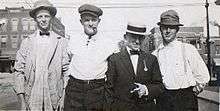
Although the Irish Catholics started very low on the social status scale, by 1900 they had jobs and earnings about equal on average to their neighbors. This was largely due to their ability to speak English when they arrived. The Irish were able to rise quickly within the working world, unlike non-English speaking immigrants.[248] Yet there were still many shanty and lower working class communities in Chicago, Philadelphia, Boston, New York, and other parts of the country.[249]
After 1945, the Catholic Irish consistently ranked at the top of the social hierarchy, thanks especially to their high rate of college attendance, and due to that many Irish American men have risen to higher socio-economic table.[250]
Local government
In the 19th century, jobs in local government were distributed by politicians to their supporters, and with significant strength in city hall the Irish became candidates for positions in all departments, such as police departments, fire departments, public schools and other public services of major cities. In 1897 New York City was formed by consolidating its five boroughs. That created 20,000 new patronage jobs. New York invested heavily in large-scale public works. This produced thousands of unskilled and semi-skilled jobs in subways, street railways, waterworks, and port facilities. Over half the Irish men employed by the city worked in utilities. Across all ethnic groups In New York City, municipal employment grew from 54,000 workers in 1900 to 148,000 in 1930.[251] In New York City, Albany, and Jersey City, about one third of the Irish of the first and second generation had municipal jobs in 1900.[252]
Police
By 1855, according to New York Police Commissioner George W. Matsell (1811–1877),[253] almost 17 percent of the police department's officers were Irish-born (compared to 28.2 percent of the city) in a report to the Board of Aldermen;[254] of the NYPD's 1,149 men, Irish-born officers made up 304 of 431 foreign-born policemen.[116] In the 1860s more than half of those arrested in New York City were Irish born or of Irish descent but nearly half of the city's law enforcement officers were also Irish. By the turn of the 20th century, five out of six NYPD officers were Irish born or of Irish descent. As late as the 1960s, 42% of the NYPD were Irish Americans.[255]
Up to the 20th and early 21st century, Irish Catholics continue to be prominent in the law enforcement community, especially in the Northeastern United States. The Emerald Society, an Irish American fraternal organization, was founded in 1953 by the NYPD.[256] When the Boston chapter of the Emerald Society formed in 1973, half of the city's police officers became members.
Teachers
Towards the end of the 19th century, schoolteaching became the most desirable occupation for the second generation of female Irish immigrants. Teaching was similar to domestic work for the first generation of Irish immigrants in that it was a popular job and one that relied on a woman's decision to remain unmarried.[257] The disproportionate number of Irish-American Catholic women who entered the job market as teachers in the late 19th century and early 20th century from Boston to San Francisco was a beneficial result of the Irish National school system. Irish schools prepared young single women to support themselves in a new country, which inspired them to instill the importance of education, college training, and a profession in their American-born daughters even more than in their sons. Evidence from schools in New York City illustrate the upward trend of Irish women as teachers: "as early as 1870, twenty percent of all schoolteachers were Irish women, and...by 1890 Irish females comprised two-thirds of those in the Sixth Ward schools." Irish women attained admirable reputations as schoolteachers, which enabled some to pursue professions of even higher stature.[258]
Nuns
Upon arrival in the United States, many Irish women became Catholic nuns and participated in the many American sisterhoods, especially those in St. Louis in Missouri, St. Paul in Minnesota, and Troy in New York. Additionally, the women who settled in these communities were often sent back to Ireland to recruit. This kind of religious lifestyle appealed to Irish female immigrants because they outnumbered their male counterparts and the Irish cultural tendency to postpone marriage often promoted gender separation and celibacy. Furthermore, "the Catholic church, clergy, and women religious were highly respected in Ireland," making the sisterhoods particularly attractive to Irish immigrants.[259] Nuns provided extensive support for Irish immigrants in large cities, especially in fields such as nursing and teaching but also through orphanages, widows' homes, and housing for young, single women in domestic work.[260] Although many Irish communities built parish schools run by nuns, the majority of Irish parents in large cities in the East enrolled their children in the public school system, where daughters or granddaughters of Irish immigrants had already established themselves as teachers.[261]
Discrimination
.jpg)
Catholics and Protestants kept their distance; intermarriage between Catholics and Protestants was uncommon, and strongly discouraged by both Protestant ministers and Catholic priests. As Dolan notes, "'Mixed marriages', as they were called, were allowed in rare cases, were warned against repeatedly, and were uncommon."[263] Rather, intermarriage was primarily with other ethnic groups who shared their religion. Irish Catholics, for example, would commonly intermarry with German Catholics or Poles in the Midwest and Italians in the Northeast.
Irish-American journalists "scoured the cultural landscape for evidence of insults directed at the Irish in America." Much of what historians know about hostility to the Irish comes from their reports in Irish and in Democratic newspapers.[264]
While the parishes were struggling to build parochial schools, many Catholic children attended public schools. The Protestant King James Version of the Bible was widely used in public schools, but Catholics were forbidden by their church from reading or reciting from it.[265] Many Irish children complained that Catholicism was openly mocked in the classroom. In New York City, the curriculum vividly portrayed Catholics, and specifically the Irish, as villainous.[266] The Catholic archbishop John Hughes, an immigrant to America from County Tyrone, Ireland, campaigned for public funding of Catholic education in response to the bigotry. While never successful in obtaining public money for private education, the debate with the city's Protestant elite spurred by Hughes' passionate campaign paved the way for the secularization of public education nationwide. In addition, Catholic higher education expanded during this period with colleges and universities that evolved into such institutions as Fordham University and Boston College providing alternatives to Irish who were not otherwise permitted to apply to other colleges.
Prejudice against Irish Catholics in the U.S. reached a peak in the mid-1850s with the Know Nothing Movement, which tried to oust Catholics from public office. After a year or two of local success, the Know Nothing Party vanished.[267] Some historians, however, maintain that actual job discrimination was minimal.[262]
Many Irish work gangs were hired by contractors to build canals, railroads, city streets and sewers across the country.[116] In the South, they underbid slave labor.[268] One result was that small cities that served as railroad centers came to have large Irish populations.[269]
In 1895, the Knights of Equity was founded, to combat discrimination against Irish Catholics in the U.S., and to assist them financially when needed.
Stereotypes
Irish Catholics were popular targets for stereotyping in the 19th century. According to historian George Potter, the media often stereotyped the Irish in America as being boss-controlled, violent (both among themselves and with those of other ethnic groups), voting illegally, prone to alcoholism and dependent on street gangs that were often violent or criminal. Potter quotes contemporary newspaper images:
You will scarcely ever find an Irishman dabbling in counterfeit money, or breaking into houses, or swindling; but if there is any fighting to be done, he is very apt to have a hand in it." Even though Pat might "'meet with a friend and for love knock him down,'" noted a Montreal paper, the fighting usually resulted from a sudden excitement, allowing there was "but little 'malice prepense' in his whole composition." The Catholic Telegraph of Cincinnati in 1853, saying that the "name of 'Irish' has become identified in the minds of many, with almost every species of outlawry," distinguished the Irish vices as "not of a deep malignant nature," arising rather from the "transient burst of undisciplined passion," like "drunk, disorderly, fighting, etc., not like robbery, cheating, swindling, counterfeiting, slandering, calumniating, blasphemy, using obscene language, &c.[270]
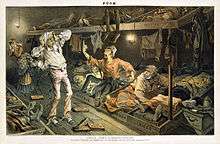
The Irish had many humorists of their own, but were scathingly attacked in political cartoons, especially those in Puck magazine from the 1870s to 1900; it was edited by secular Germans who opposed the Catholic Irish in politics. In addition, the cartoons of Thomas Nast were especially hostile; for example, he depicted the Irish-dominated Tammany Hall machine in New York City as a ferocious tiger.[271]
The stereotype of the Irish as violent drunks has lasted well beyond its high point in the mid-19th century. For example, President Richard Nixon once told advisor Charles Colson that "[t]he Irish have certain — for example, the Irish can't drink. What you always have to remember with the Irish is they get mean. Virtually every Irish I've known gets mean when he drinks. Particularly the real Irish."[272]
Discrimination against Irish Americans differed depending on gender. For example, Irish women were sometimes stereotyped as "reckless breeders" because some American Protestants feared high Catholic birth rates would eventually result in a Protestant minority. Many native-born Americans claimed that "their incessant childbearing [would] ensure an Irish political takeover of American cities [and that] Catholicism would become the reigning faith of the hitherto Protestant nation."[273] Irish men were also targeted, but in a different way than women were. The difference between the Irish female "Bridget" and the Irish male "Pat" was distinct; while she was impulsive but fairly harmless, he was "always drunk, eternally fighting, lazy, and shiftless". In contrast to the view that Irish women were shiftless, slovenly and stupid (like their male counterparts), girls were said to be "industrious, willing, cheerful, and honest—they work hard, and they are very strictly moral".[274][275]
There were also Social Darwinian-inspired excuses for the discrimination of the Irish in America. Many Americans believed that since the Irish were Celts and not Anglo-Saxons, they were racially inferior and deserved second-hand citizenship. The Irish being of inferior intelligence was a belief held by many Americans. This notion was held due to the fact that the Irish topped the charts demographically in terms of arrests and imprisonment. They also had more people confined to insane asylums and poorhouses than any other group. The racial supremacy belief that many Americans had at the time contributed significantly to Irish discrimination.[276]
Contributions to American culture
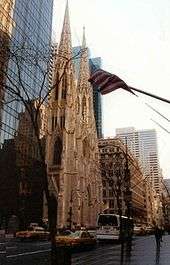
The annual celebration of Saint Patrick's Day is a widely recognized symbol of the Irish presence in America. The largest celebration of the holiday takes place in New York, where the annual St. Patrick's Day Parade draws an average of two million people. The second-largest celebration is held in Boston. The South Boston Parade is one the nation's oldest, dating back to 1737. Savannah, Georgia, also holds one of the largest parades in the United States.
Since the arrival of nearly two million Irish immigrants in the 1840s, the urban Irish police officer and firefighter have become virtual icons of American popular culture. In many large cities, the police and fire departments have been dominated by the Irish for over 100 years, even after the ethnic Irish residential populations in those cities dwindled to small minorities. Many police and fire departments maintain large and active "Emerald Societies", bagpipe marching groups, or other similar units demonstrating their members' pride in their Irish heritage.
While these archetypal images are especially well known, Irish Americans have contributed to U.S. culture in a wide variety of fields: the fine and performing arts, film, literature, politics, sports, and religion. The Irish-American contribution to popular entertainment is reflected in the careers of figures such as James Cagney, Bing Crosby, Walt Disney, John Ford, Judy Garland,[277] Gene Kelly, Grace Kelly, Tyrone Power, Chuck Connors, Ada Rehan, Jena Malone, and Spencer Tracy. Irish-born actress Maureen O'Hara,[278] who became an American citizen, defined for U.S. audiences the archetypal, feisty Irish "colleen" in popular films such as The Quiet Man and The Long Gray Line. More recently, the Irish-born Pierce Brosnan gained screen celebrity as James Bond. During the early years of television, popular figures with Irish roots included Gracie Allen, Art Carney, Joe Flynn, Jackie Gleason, Luke Gordon and Ed Sullivan.
Since the late days of the film industry, celluloid representations of Irish Americans have been plentiful. Famous films with Irish-American themes include social dramas such as Little Nellie Kelly and The Cardinal, labor epics like On the Waterfront, and gangster movies such as Angels with Dirty Faces, The Friends of Eddie Coyle, and The Departed. Irish-American characters have been featured in popular television series such as Ryan's Hope, Rescue Me and Blue Bloods.
Prominent Irish-American literary figures include Pulitzer and Nobel Prize–winning playwright Eugene O'Neill, Jazz Age novelist F. Scott Fitzgerald, author and poet Edgar Allan Poe,[279] social realist James T. Farrell, and Southern Gothic writer Flannery O'Connor. The 19th-century novelist Henry James was also of partly Irish descent. While Irish Americans have been underrepresented in the plastic arts, two well-known American painters claim Irish roots. 20th-century painter Georgia O'Keeffe was born to an Irish-American father, and 19th-century trompe-l'œil painter William Harnett emigrated from Ireland to the United States.
The Irish-American contribution to politics spans the entire ideological spectrum. Two prominent American socialists, Mary Harris "Mother" Jones and Elizabeth Gurley Flynn, were Irish Americans. In the 1960s, Irish-American writer Michael Harrington became an influential advocate of social welfare programs. Harrington's views profoundly influenced President John F. Kennedy and his brother, Robert F. Kennedy. Meanwhile, Irish-American political writer William F. Buckley emerged as a major intellectual force in American conservative politics in the latter half of the 20th century. Buckley's magazine, National Review, proved an effective advocate of successful Republican candidates such as Ronald Reagan.
Notorious Irish Americans include the legendary New Mexico outlaw Billy the Kid.[280][281] Many historians believe he was born in New York City to Famine-era immigrants from Ireland.[280][281] Mary Mallon, also known as Typhoid Mary, was an Irish immigrant, as was madam Josephine Airey, who also went by the name of "Chicago Joe" Hensley. New Orleans socialite and murderer Delphine LaLaurie, whose maiden name was Macarty, was of partial paternal Irish ancestry. Irish-American mobsters include, amongst others, Dean O'Banion, Jack "Legs" Diamond, Buddy McLean, Howie Winter and Whitey Bulger. Lee Harvey Oswald, the assassin of John F. Kennedy, had an Irish-born great-grandmother by the name of Mary Tonry.[282] Colorful Irish Americans also include Margaret Tobin of RMS Titanic fame, scandalous model Evelyn Nesbit, dancer Isadora Duncan, San Francisco madam Tessie Wall, and Nellie Cashman, nurse and gold prospector in the American West.
The wide popularity of Celtic music has fostered the rise of Irish-American bands that draw heavily on traditional Irish themes and music. Such groups include New York City's Black 47, founded in the late 1980s, blending punk rock, rock and roll, Irish music, rap/hip-hop, reggae, and soul; and the Dropkick Murphys, a Celtic punk band formed in Quincy, Massachusetts, nearly a decade later. The Decemberists, a band featuring Irish-American singer Colin Meloy, released "Shankill Butchers", a song that deals with the Ulster Loyalist gang of the same name. The song appears on their album The Crane Wife. Flogging Molly, led by Dublin-born Dave King, are relative newcomers building upon this new tradition.
Sports
Starting with the sons of the famine generation, the Irish dominated baseball and boxing, and played a major role in other sports.
Famous in their day were NFL quarterbacks and Super Bowl champions John Elway and Tom Brady, NBA forward Rick Barry,[283] tennis greats Jimmy Connors and John McEnroe, baseball pitcher Nolan Ryan, baseball shortstop Derek Jeter, basketball point guard Jason Kidd, boxing legend Jack Dempsey, world champion pro surfer Kelly Slater, national champion skier Ryan Max Riley, and legendary golfer Ben Hogan.
Baseball
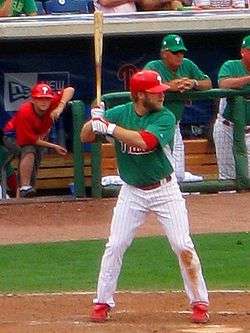
The Irish dominated professional baseball in the late 19th century, making up a third or more of the players and many of the top stars and managers. The professional teams played in northeastern cities with large Irish populations that provided a fan base, as well as training for ambitious youth.[284] Casway argues that:
Baseball for Irish kids was a shortcut to the American dream and to self-indulgent glory and fortune. By the mid-1880s these young Irish men dominated the sport and popularized a style of play that was termed heady, daring, and spontaneous.... Ed Delahanty personified the flamboyant, exciting spectator-favorite, the Casey-at-the-bat, Irish slugger. The handsome masculine athlete who is expected to live as large as he played.[285]
Irish stars included Charles Comiskey, Connie Mack, Michael "King" Kelly, Roger Connor, Eddie Collins, Roger Bresnahan, Ed Walsh and New York Giants manager John McGraw. The large 1945 class of inductees enshrined in the National Baseball Hall of Fame in Cooperstown included nine Irish Americans.
The Philadelphia Phillies always play at home during spring training on St. Patrick's Day. The Phillies hold the distinction of being the first baseball team to wear green uniforms on St. Patricks Day. The tradition was started by Phillies pitcher Tug McGraw, who dyed his uniform green the night before March 17, 1981.[286]
Boxing
John L. Sullivan (1858–1918), The heavyweight boxing champion, was the first of the modern sports superstars, winning scores of contests – perhaps as many as 200—with a purse that reached the fabulous sum of one million dollars.[287][288]
Gaelic sports
The Irish brought their native games of handball, hurling and Gaelic football to America. Along with camogie, these sports are part of the Gaelic Athletic Association. The North American GAA organization is still strong, with 128 clubs across its 10 divisions.[289]
Entertainment

Irish Americans have been prominent in comedy. Notable comedians of Irish descent include Jackie Gleason, George Carlin, Bill Burr, Bill Murray, Will Ferrell, Bryan Callen, Pete Holmes, Joe Rogan, Ben Stiller, Chris Farley, Stephen Colbert, Conan O'Brien, Denis Leary (holds dual American and Irish citizenship),[292] Colin Quinn, Charles Nelson Reilly, Bill Maher, Molly Shannon, John Mulaney, Kathleen Madigan, Jimmy Fallon, Des Bishop, and Jim Gaffigan, among others. Musicians of Irish descent include Christina Aguilera, Kelly Clarkson, Kurt Cobain, Bing Crosby, Tori Kelly, Tim McGraw, Mandy Moore, Hilary Duff, Fergie, Judy Garland, Katy Perry, Tom Petty, Pink, Elvis Presley, Britney Spears, Bruce Springsteen, Gwen Stefani, Taylor Swift, Justin Timberlake, Prodigy, Post Malone Trippie Redd and others.
Fictional Irish Americans: In the Comic Strips:
- Maggie and Jiggs of Bringing Up Father
- Police Chief Pat Patton of Dick Tracy
- Beetle Bailey and his sister Lous {Bailey} Flagston of Beetle Bailey and Hi and Lois[293]
Sense of heritage
Many people of Irish descent retain a sense of their Irish heritage. Article 2 of the Constitution of Ireland formally recognizes and embraces this fact:
…the Irish Nation cherishes its special affinity with people of Irish ancestry living abroad who share its cultural identity and heritage.

Irish independence from the United Kingdom encouraged the hope that descendants of Irish abroad who had retained a cultural connection and identified with Ireland would resettle there, as opposed to attracting immigrants from other cultures in other countries. One member of an Irish government of the early republic expressed his hope as follows:
I do not think [the Irish Free State] will afford sufficient allurements to the citizens of other States ... The children of Irish parents born abroad are sometimes more Irish than the Irish themselves, and they would come with added experience and knowledge to our country....|4=Sen. Patrick Kenny, Seanad Éireann 1924, [294]
A sense of exile, diaspora, and (in the case of songs) even nostalgia is a common theme.[295][296] The modern term "Plastic Paddy" generally refers to someone who was not born in Ireland and is separated from his closest Irish-born ancestor by several generations but still considers themselves "Irish". It is occasionally used in a derogatory fashion towards Irish Americans, in an attempt to undermine the "Irishness" of the Irish diaspora based on nationality and (citizenship) rather than ethnicity.[297][298][299] The term is freely applied to relevant people of all nationalities, not solely Irish Americans.
Some Irish Americans were enthusiastic supporters of Irish independence; the Fenian Brotherhood movement was based in the United States and in the late 1860s launched several unsuccessful attacks on British-controlled Canada known as the "Fenian Raids".[300] The Provisional IRA received significant funding and volunteers for its paramilitary activities from Irish expatriates and Irish American supporters—in 1984, the US Department of Justice won a court case forcing the Irish American fund-raising organization NORAID to acknowledge the Provisional IRA as its "foreign principal".[301]
Cities

The vast majority of Irish Catholic Americans settled in large and small cities across the North, particularly railroad centers and mill towns. They became perhaps the most urbanized group in America, as few became farmers.[302] Areas that retain a significant Irish American population include the metropolitan areas of Boston, New York City, Philadelphia, Providence, Hartford, Pittsburgh, Buffalo, Albany, Syracuse, Baltimore, St. Louis, Chicago, Cleveland, San Francisco, Savannah, and Los Angeles, where most new arrivals of the 1830–1910 period settled. As a percentage of the population, Massachusetts is the most Irish state, with about a fifth, 21.2%, of the population claiming Irish descent.[303] The most Irish American towns in the United States are Scituate, Massachusetts, with 47.5% of its residents being of Irish descent; Milton, Massachusetts, with 44.6% of its 26,000 being of Irish descent; and Braintree, Massachusetts, with 46.5% of its 34,000 being of Irish descent. (Weymouth, Massachusetts, at 39% of its 54,000 citizens, and Quincy, Massachusetts, at 34% of its population of 90,000, are the two most Irish cities in the country. Squantum, a peninsula in the northern part of Quincy, is the most Irish neighborhood in the country, with close to 60% of its 2600 residents claiming Irish descent.)[304]
Philadelphia, Boston, New York, and Chicago have historically had neighborhoods with higher percentages of Irish American residents. Regionally, the most Irish American states are Massachusetts, New Hampshire, Maine, Vermont, Rhode Island, Delaware, Pennsylvania, and Connecticut, according to the U.S. Census Bureau American Community Survey in 2013.[305] In consequence of its unique history as a mining center, Butte, Montana, is also one of the country's most thoroughly Irish American cities.[306] Smaller towns, such as Greeley, Nebraska (population 466), with an estimated 51.7% of the residents identifying as Irish American as of 2009–13[307][308] were part of the Irish Catholic Colonization effort of Bishop O'Connor of New York in the 1880s.[309]
The states with the top percentages of Irish:
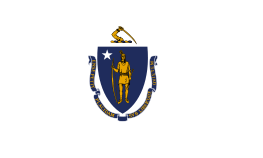

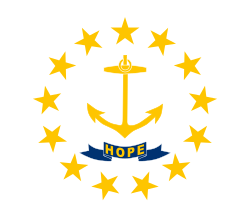
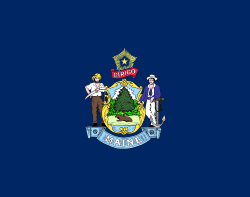
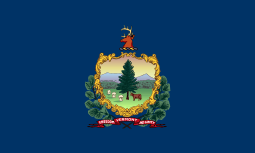
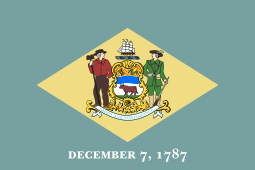
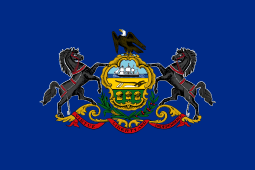

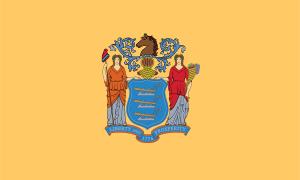
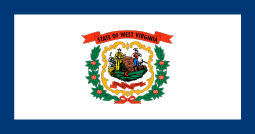


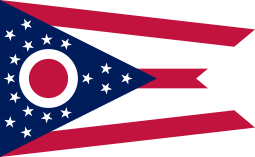

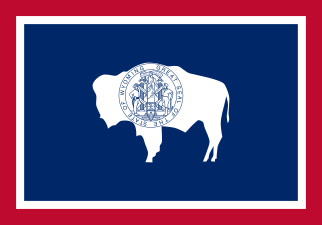

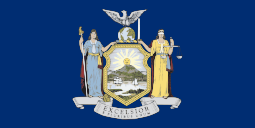

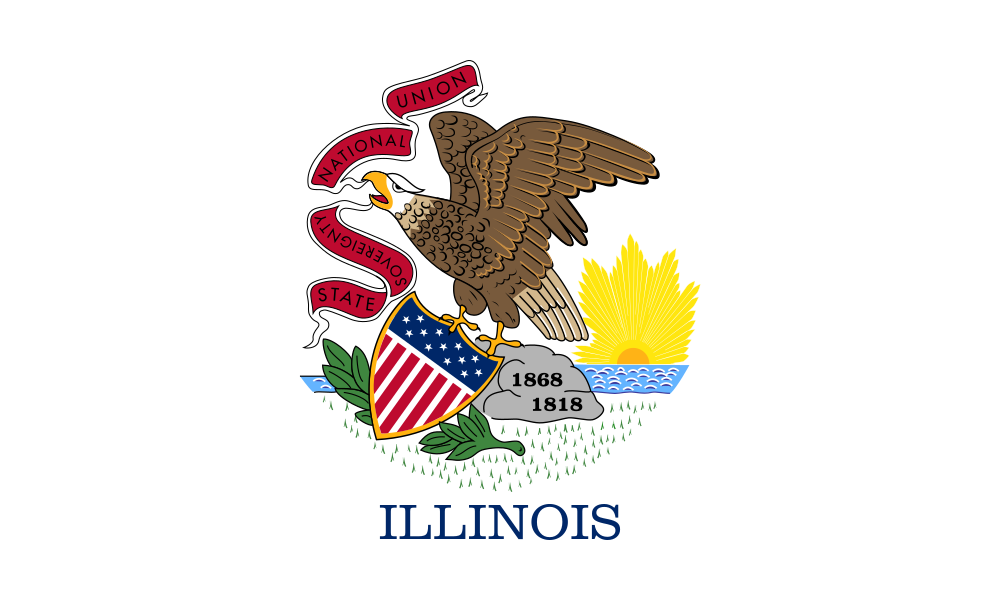
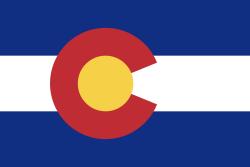
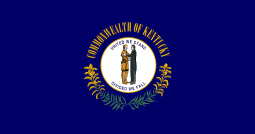
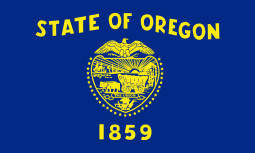
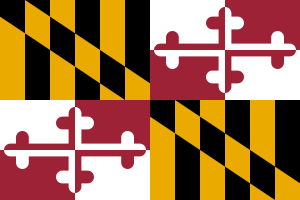

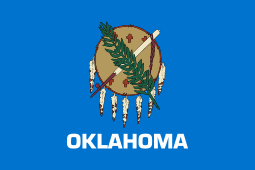
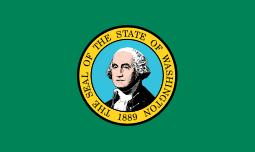
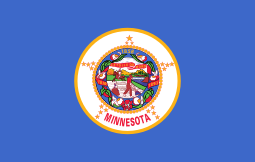

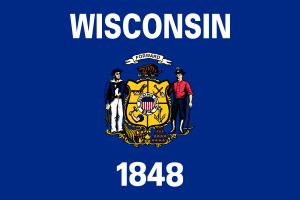

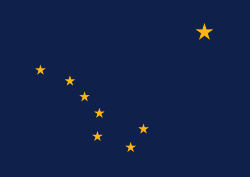
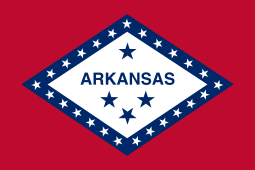
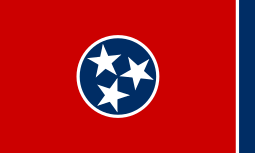
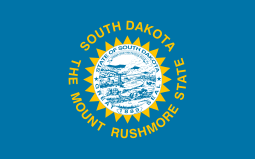

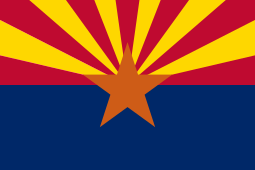



.svg.png)
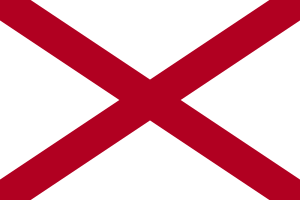
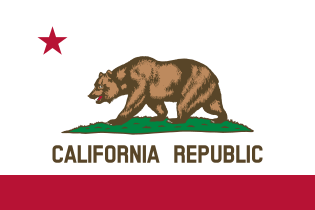

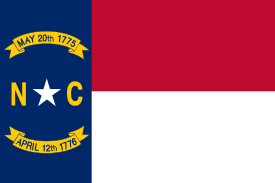

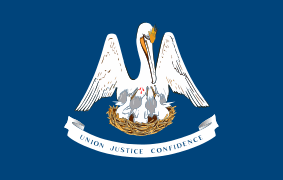

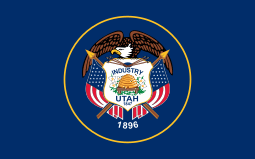
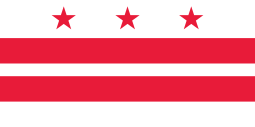
Irish-American communities
According to the 2010 U.S. Census, the city of Butte, Montana has the highest percentage of Irish Americans per capita of any city in the United States, with around one-quarter of the population reporting Irish ancestry.[310][311] Butte's Irish Catholic population originated with the waves of Irish immigrants who arrived in the city in the late-nineteenth century to work in the industrial mines. By population, however, Boston and Philadelphia have the two largest Irish American populations in the country. There are Irish neighborhoods scattered all throughout Boston, most notably South Boston. Many of Philadelphia's Irish neighborhoods are located in the Northeast Philadelphia section of the city, particularly in the Fishtown, Mayfair, and Kensington neighborhoods, as well as the South Philadelphia section, most notably the Pennsport ("Two Street" to the locals) neighborhood. There are large Irish populations in the Boston and Philadelphia metropolitan areas as well. The South Side of Chicago, Illinois also has a large Irish community, who refer to themselves as the Southside Irish.
Notable people
In politics and government
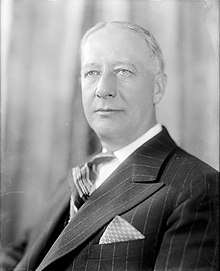
The United States Declaration of Independence contained 56 delegate signatures. Of the signers, eight were of Irish descent. Three signers, Matthew Thornton, George Taylor and James Smith, were born in Ireland; the remaining five Irish Americans, George Read, Thomas McKean, Thomas Lynch Jr., Edward Rutledge, and Charles Carroll, were the sons or grandsons of Irish immigrants. Though not a delegate but the secretary at the Congress, Charles Thomson, also Irish American, signed as well. The United States Constitution was created by a convention of 36 delegates. Of these, at least six were of Irish ancestry. George Read and Thomas McKean had already worked on the Declaration, and were joined by John Rutledge, William Paterson, Pierce Butler, Daniel Carroll, and Thomas Fitzsimons. The Carrolls and Fitzsimons were Catholic, the remainder Protestant.[312][313]
By the 1850s, the Irish were already a major presence in the police departments of large cities. In New York City in 1855, of the city's 1,149 policemen, 305 were natives of Ireland. Within 30 years, Irish Americans in the NYPD were almost twice their proportion of the city's population.[116] Both Boston's police and fire departments provided many Irish immigrants with their first jobs. The creation of a unified police force in Philadelphia opened the door to the Irish in that city. By 1860 in Chicago, 49 of the 107 on the police force were Irish. Chief O'Leary headed the police force in New Orleans, and Malachi Fallon was chief of police of San Francisco.[314]
The Irish Catholic diaspora are very well-organized and since 1850 have produced a majority of the leaders of the U.S. Catholic Church, labor unions, the Democratic Party in larger cities, and Catholic high schools, colleges and universities.[315]
Many major cities have elected Irish American Catholic mayors. Indeed, Boston, Philadelphia, Baltimore, Cincinnati, Houston, Newark, New York City, Omaha, Scranton, Pittsburgh, St. Louis, Saint Paul, and San Francisco have all elected natives of Ireland as mayors. Chicago, Boston, and Jersey City, New Jersey have had more Irish American mayors than any other ethnic group. The cities of Milwaukee (Tom Barrett; 2004-) and Detroit (Mike Duggan; 2012-) currently (as of 2018) have Irish American mayors. Pittsburgh mayor Bob O'Connor died in office in 2006. New York City has had at least three Irish-born mayors and over eight Irish American mayors. The most recent one was County Mayo native William O'Dwyer, first elected in 1945.[316][317]. Beginning in the 1909 mayoral election, every Democratic candidate for mayor of New York City was a man of Irish descent until 1950, when a special election saw three Italian Americans as the top vote getters.[318]
The Irish Protestant vote has not been studied nearly as much. Historian Timothy J. Meagher argues that by the late 19th century, most of the Protestant Irish "turned their backs on all associations with Ireland and melted into the American Protestant mainstream." A minority insisted on a "Scotch-Irish" identity.[319]
In Canada, by contrast, Irish Protestants remained a political force, with many belonging to the Orange Order.[320] It was an anti-Catholic social organization with chapters across Canada. It was most powerful during the late 19th century.[321][322]
Political leanings
Al Smith and later John F. Kennedy were the political heroes for Catholics.[323] Al Smith, who had an Irish mother and an English-German father, in 1928 became the first Catholic to run for president.[324] From the 1830s to the 1960s, Irish Catholics voted heavily Democratic, with occasional exceptions like the election of 1920. Their precincts showed average support levels of 80%.[325] As historian Lawrence McCaffrey notes, "until recently they have been so closely associated with the Democratic party that Irish, Catholic, and Democrat composed a trinity of associations, serving mutual interests and needs. "[326]
The great majority of Irish Catholic politicians were Democrats, with a few exceptions before 1970 such as Connecticut Senator John A. Danaher and Wisconsin Senator Joseph McCarthy.[327] Today, Irish politicians are associated with both parties. Ronald Reagan boasted of his Irishness. Historically, Irish Catholics controlled prominent Democratic city organizations.[328] Among the most prominent were New York, Philadelphia, Chicago, Boston, San Francisco, Pittsburgh, Jersey City, and Albany.[329] Many served as chairmen of the Democratic National Committee, including County Monaghan native Thomas Taggart, Vance McCormick, James Farley, Edward J. Flynn, Robert E. Hannegan, J. Howard McGrath, William H. Boyle, Jr., John Moran Bailey, Larry O'Brien, Christopher J. Dodd, Terry McAuliffe and Tim Kaine. In Congress, the Irish are represented in both parties; currently, Susan Collins of Maine, Pat Toomey of Pennsylvania, Bob Casey, Jr. of Pennsylvania, Ed Markey of Massachusetts, Dan Sullivan of Alaska, Lisa Murkowski of Alaska, Dick Durbin of Illinois, Patrick Leahy of Vermont, and Maria Cantwell of Washington are Irish Americans serving in the United States Senate. Former Speaker of the House of Representatives and Vice Presidential Candidate Paul Ryan is another prominent Irish-American Republican. Exit polls show that in recent presidential elections Irish Catholics have split about 50–50 for Democratic and Republican candidates.[330] The pro-life faction in the Democratic party includes many Irish Catholic politicians, such as the former Boston mayor and ambassador to the Vatican Ray Flynn and senator Bob Casey, Jr., who defeated Senator Rick Santorum in a high visibility race in Pennsylvania in 2006.[331]
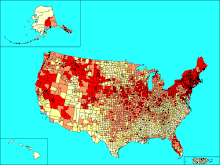
In New York State where fusion voting is practiced, Irish Americans were instrumental in the founding of the Conservative party in opposition to Nelson Rockefeller and other liberal Republicans who dominated the state GOP during the 1960s and 70s.[332] The party, founded by Irish American lawyers J. Daniel Mahoney and Kieran O'Doherty would serve as a vehicle for William F. Buckley when he ran for mayor of New York in 1965 against liberal WASP Republican John V. Lindsay and establishment Democrat Abe Beame. Elsewhere, significant majorities of the local Irish stayed with the Democratic party, such as in Massachusetts and in other parts of Southern New England.[333] In some heavily Irish small towns in Northern New England the Irish vote is quite Republican, but other places like Gloucester, New Jersey and Butte, Montana which retain strongly liberal and Democratic leaning Irish populations. In the 1984 United States Presidential Election Irish Catholics in Massachusetts voted 56 to 43 for Walter Mondale while their cousins in New York State voted 68 to 32 for Ronald Reagan.[334]
The voting intentions of Irish Americans and other white ethnic groups attracted attention in the 2016 US election. In the Democratic primaries, Boston's Irish were said to break strongly for Hillary Clinton, whose victories in Irish-heavy Boston suburbs may have helped her narrowly carry the state over Bernie Sanders.[335] A 2016 March survey by Irish Central [336] showed that 45% of Irish Americans nationwide supported Trump, although the majority of those in Massachusetts supported Hillary Clinton. An October poll by Buzzfeed showed that Irish respondents nationwide split nearly evenly between Trump (40%) and Clinton (39%), with large numbers either undecided or supporting other candidates (21%), and that the Irish were more supportive of Clinton than all the other West European-descended Americans including fellow Catholic Italian Americans.[337] In early November 2016, six days before the election, another poll by IrishCentral showed Clinton ahead at 52% among Irish Americans, while Trump was at 40% and the third party candidates together had 8%; Irish respondents in Massachusetts similarly favored Clinton by majority.[338] In the official 2016 election results, Irish-heavy Boston suburbs including on the South Shore witnessed swings to the left (Scituate: +19.5% D, Cohasset: +32.8% D, Milton: +26.6% D, etc.) even as the country as a whole moved right. This caused many of the most heavily Irish-descended communities in the country, such as Scituate, to flip from split or Republican-voting to Democrat-voting by significant margins (Scituate: +18% D, Hull: +21% D, Cohasset: +24% D, Milton: +41% D). Despite voting against Trump, many of these same communities had some of the highest levels of opposition to the legalization of marijuana, a typically socially conservative position.
In 2017, a survey with 3,181 Irish American respondents (slightly over half being beyond 3rd generation) by Irish Times found that 41% identified as Democrats while 23% identified as Republicans, while 45% used NBC (typically considered left-leaning) for their news while 36% used Fox News (considered right-leaning).[339]
The presence of supporters of Trump among Irish and other white ethnic communities which had once themselves been marginalized immigrants generated controversy, with progressive Irish American media figures admonishing their co-ethnics against "myopia" and "amnesia".[340] However, such criticisms by left leaning pundits were frequently leveled against Irish-American conservatives prior to Trump's presidential run, with one columnist from the liberal online magazine Salon calling Irish-American conservatives "disgusting" in 2014.[341] In New York City, the rise of the woke left in the Democratic Party, in addition to the ongoing trends of suburbanization, gentrification, the rise of hipster culture, and the increased tendency of Irish-Americans to vote Republican has led to the collapse of Irish political power in the city during the 2010s.[342] This trend was exemplified by the defeat of Queens Representative and former House Democratic Caucus Chairman Joe Crowley by democratic socialist Alexandria Ocasio-Cortez in the 2018 Democratic primary.[343][344]
American presidents with Irish ancestry
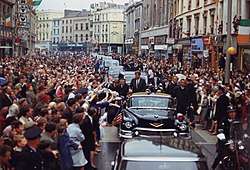

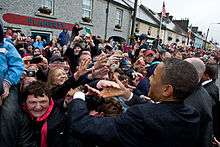
A number of the presidents of the United States have Irish origins.[345] The extent of Irish heritage varies. For example, Chester Arthur's father and both of Andrew Jackson's parents were Irish-born, while George W. Bush has a rather distant Irish ancestry. Ronald Reagan's father was of Irish ancestry,[346] while his mother also had some Irish ancestors. John F. Kennedy had Irish lineage on both sides. Within this group, only Kennedy was raised as a practicing Roman Catholic. Barack Obama's Irish heritage originates from his Kansas-born mother, Ann Dunham, whose ancestry is Irish and English.[347]
- John F. Kennedy
- 35th President 1961–63 (Limerick and County Wexford) First Catholic president, Irish Catholic
- Ronald Reagan
- 40th President 1981–89: He was the great-grandson, on his father's side, of Irish migrants from County Tipperary who came to America via Canada and England in the 1840s. His mother was of Scottish and English ancestry.[348]
- George H. W. Bush
- 41st President 1989–93 (County Wexford): historians have found that his now apparent ancestor, Richard de Clare, Earl of Pembroke, shunned by Henry II, offered his services as a mercenary in the 12th-century Norman invasion of Wexford in exchange for power and land. Strongbow married Aoife, daughter of Dermot MacMurrough, the Gaelic king of Leinster.[349][350]
- George W. Bush
- 43rd President 2001–09: One of his five times great-grandfathers, William Holliday (a British merchant living in Ireland), was born in Rathfriland, County Down, about 1755 and died in Kentucky about 1811–12. One of the President's seven times great-grandfathers, William Shannon, was born somewhere in County Cork about 1730, and died in Pennsylvania in 1784.[350]
- Barack Obama
- 44th President 2009–2017: Some of his maternal ancestors came to America from a small village called Moneygall, in County Offaly.[347][351][352] His ancestors lived in New England and the South and, by the 1800s, most were in the Midwest.
Vice Presidents of Irish descent
- Joe Biden
- 47th Vice President 2009–2017[353]
- Mike Pence
- 48th Vice President 2017–present
Speakers of the U.S. House of Representatives
- Joseph W. Martin Jr. (44th Speaker of the U.S. House of Representatives, 1947–1949 & 1953–1955; House Republican Conference Leader, 1939–1959; House Minority Leader, 1939–1947, 1949–1953 & 1955–1959; U.S. Representative from Massachusetts's 15th congressional district, 1925–1933; U.S. Representative from Massachusetts's 14th congressional district, 1933–1963; U.S. Representative from Massachusetts's 10th congressional district, 1963–1967; Republican National Committee Chair, 1940–1942)
- John W. McCormack (45th Speaker of the U.S. House of Representatives, 1962–1971; House Democratic Caucus Leader, 1962–1971; House Majority Leader, 1940–1947, 1949–1953 & 1955–1962; House Minority Whip, 1947–1949 & 1953–1955; U.S. Representative from Massachusetts's 12th congressional district, 1928–1963; U.S. Representative from Massachusetts's 9th congressional district, 1963–1971; Massachusetts State Senator, 1923–1928)
- Tip O'Neill (47th Speaker of the U.S. House of Representatives, 1977–1987; House Democratic Caucus Leader, 1977–1987; House Majority Leader, 1973–1977; House Minority Whip, 1971–1973; U.S. Representative from Massachusetts's 11th congressional district, 1953–1963; U.S. Representative from Massachusetts's 8th congressional district, 1963–1987; Speaker of the Massachusetts House of Representatives, 1949–1953; Minority Leader of the Massachusetts House of Representatives, 1947–1949)
- Jim Wright (48th Speaker of the U.S. House of Representatives, 1987–1989; House Democratic Caucus Leader, 1987–1989; House Majority Leader, 1977–1987; U.S. Representative from Texas's 12th congressional district, 1955–1989; U.S. Army Air Force 2nd Lieutenant, 1942–1946)
- Tom Foley (49th Speaker of the U.S. House of Representatives, 1989–1995; House Democratic Caucus Leader, 1989–1995; House Majority Leader, 1987–1989; House Majority Whip, 1981–1987; U.S. Representative from Washington's 5th congressional district, 1965–1995; House Agriculture Committee Chair, 1975–1981; President's Intelligence Advisory Board Chair, 1996–1997; 25th U.S. Ambassador to Japan, 1997–2001)
- John Boehner (53rd Speaker of the U.S. House of Representatives, 2011–2015; House Republican Conference Leader, 2007–2015; House Majority Leader, 2006–2007; House Education Committee Chair, 2001–2006; U.S. Representative from Ohio's 8th congressional district, 1991–2015; Ohio State Representative, 1985–1991)
- Paul Ryan (54th Speaker of the U.S. House of Representatives, 2015–2019; House Republican Conference Leader, 2015–2019; House Ways and Means Committee Chair, 2015; House Budget Committee Chair, 2011–2015; U.S. Representative from Wisconsin's 1st congressional district, 1999–2019)
Irish-American Justices of the Supreme Court
- Joseph McKenna
- Edward D. White
- Pierce Butler
- Frank Murphy
- James Francis Byrnes
- William J. Brennan
- Anthony Kennedy
- Neil Gorsuch Partial maternal Irish ancestry
- Brett Kavanaugh
See also
- 69th Infantry Regiment (New York)
- Ethnocultural politics in the United States
- Irish American Athletic Club
- Irish American Cultural Institute
- Irish-American Heritage Month
- Irish Brigade (U.S.)
- Irish Mob, criminals in large cities
- Irish Race Conventions, 19th-century international conventions
- Irish Whales, athletes
- List of Americans of Irish descent, notable individuals
- List of Irish-American Medal of Honor recipients
- Saint Patrick's Battalion, Mexican–American War
Notes
- "B04006 – PEOPLE REPORTING SINGLE ANCESTRY 2013-2017 American Community Survey 5-Year Estimates". U.S. Census Bureau. Archived from the original on January 17, 2015. Retrieved June 3, 2019.
- "America's Most Irish Towns". Forbes.
- Carroll, Michael P. (Winter 2006). "How the Irish Became Protestant in America". Religion and American Culture. University of California Press. 16 (1): 25–54. doi:10.1525/rac.2006.16.1.25. JSTOR 10.1525/rac.2006.16.1.25.
- "Rank of States for Selected Ancestry Groups with 100,000 or more persons: 1980" (PDF). United States Census Bureau. Retrieved 30 November 2012.
- "1990 Census of Population Detailed Ancestry Groups for States" (PDF). United States Census Bureau. 18 September 1992. Retrieved 30 November 2012.
- "Ancestry: 2000". United States Census Bureau. Archived from the original on 12 February 2020. Retrieved 30 November 2012.
- "Total ancestry categories tallied for people with one or more ancestry categories reported 2010 American Community Survey 1-Year Estimates". United States Census Bureau. Archived from the original on 18 January 2015. Retrieved 30 November 2012.
- John Devoy, Seán Ó Lúing, Cló Morainn, 1961, page 145
- "Catholics - Religion in America: U.S. Religious Data, Demographics and Statistics". Pew Research Center. Retrieved June 3, 2019.
- "Evangelical Protestants - Religion in America: U.S. Religious Data, Demographics and Statistics". Pew Research Center. Retrieved June 3, 2019.
- "Mainline Protestants - Religion in America: U.S. Religious Data, Demographics and Statistics". Pew Research Center. Retrieved June 3, 2019.
- Blessing, Patrick J. (1980). "Irish". In Thernstrom, Stephan (ed.). Harvard Encyclopedia of American Ethnic Groups. Cambridge, MA: Harvard University Press. p. 528. ISBN 978-0674375123.
- Boyer, Paul S.; Clark, Clifford E.; Halttunen, Karen; Kett, Joseph F.; Salisbury, Neal; Sitkoff, Harvard; Woloch, Nancy (2013). The Enduring Vision: A History of the American People (8th ed.). Cengage Learning. p. 99. ISBN 978-1133944522.
- Miller, Kerby A.; Schrier, Arnold; Boling, Bruce D.; Doyle, David N. (2003). Irish Immigrants in the Land of Canaan: Letters and Memoirs from Colonial and Revolutionary America, 1675–1815. New York: Oxford University Press. p. 39. ISBN 978-0195045130.
In the seventeenth century, southern Irish Catholics probably constituted a large majority of the relatively few emigrants from Ireland, perhaps 30,000–50,000 in all, who crossed the Atlantic and settled primarily in the West Indies and Chesapeake.
- Swingen, Abigail L. (2015). Competing Visions of Empire: Labor, Slavery, and the Origins of the British Atlantic Empire. New Haven, CT: Yale University Press. p. 21. ISBN 978-0300187540.
- Dunaway, Wayland F. (1944). The Scots-Irish of Colonial Pennsylvania. Baltimore: Genealogical Publishing Company. p. 41.
...there were only 24,000 Catholics in the entire United States in 1783, and this number included many, perhaps a majority, from countries other than Ireland. It appears probable that Ireland furnished no more than 10,000 Catholics in America during the colonial period, and the largest segment of the Catholic population came from England, Germany, and France.
- Blackburn, Robin (1997). The Making of New World Slavery: From the Baroque to the Modern 1492-1800 (1st ed.). London: Verso Books. p. 317. ISBN 978-1844676316.
In the 1650s about eight thousand Irish captives were sent to the American colonies, many of them on ten-year penal contracts.
- Newman, Simon P. (2015). "'In Great Slavery and Bondage': White Labor and the Development of Plantation Slavery in British America". In Gallup-Diaz, Ignacio; Shankman, Andrew; Silverman, David J.; Murrin, John M. (eds.). Anglicizing America: Empire, Revolution, Republic. Philadelphia: University of Pennsylvania Press. p. 75. ISBN 978-0812246988.
One contemporary estimated that some thirty-four thousand men were sent to the Americas, close to one-sixth of Ireland’s adult male population, and more of them went to Barbados than to any other colony.
- Purvis, Thomas L. (1999). Balkin, Richard (ed.). Colonial America to 1763. New York: Facts on File. p. 153. ISBN 978-0816025275.
- Purvis, Thomas L. (1999). Balkin, Richard (ed.). Colonial America to 1763. New York: Facts on File. pp. 162–163. ISBN 978-0816025275.
- Fischer, David Hackett (1989). Albion's Seed: Four British Folkways in America. Oxford University Press. pp. 229–231. ISBN 978-0195069051.
- Galenson, David W. (March 1984). "The Rise and Fall of Indentured Servitude in the Americas: An Economic Analysis". The Journal of Economic History. Cambridge University Press. 44 (1): 1–26. doi:10.1017/s002205070003134x. JSTOR 2120553.
- Whaples, Robert (March 1995). "Where Is There Consensus Among American Economic Historians? The Results of a Survey on Forty Propositions" (PDF). The Journal of Economic History. Cambridge University Press. 55 (1): 140–144. doi:10.1017/S0022050700040602. JSTOR 2123771.
- Dolan, Jay P. (1985). The American Catholic Experience: A History from Colonial Times to the Present. New York: Doubleday. p. 73. ISBN 978-0385152068.
- Fogarty, Gerald P. (1999). "Virginia". In Glazier, Michael (ed.). The Encyclopedia of the Irish in America. Notre Dame, IN: University of Notre Dame Press. p. 928. ISBN 978-0268027551.
- Dolan, Jay P. (1985). The American Catholic Experience: A History from Colonial Times to the Present. New York: Doubleday. pp. 74–77. ISBN 978-0385152068.
- Purvis, Thomas L. (1999). Balkin, Richard (ed.). Colonial America to 1763. New York: Facts on File. p. 179. ISBN 978-0816025275.
- Dolan, Jay P. (1985). The American Catholic Experience: A History from Colonial Times to the Present. New York: Doubleday. p. 80. ISBN 978-0385152068.
- Dolan, Jay P. (1985). The American Catholic Experience: A History from Colonial Times to the Present. New York: Doubleday. pp. 82–83. ISBN 978-0385152068.
- Barck, Oscar T.; Lefler, Hugh T. (1958). Colonial America. New York: Macmillan. pp. 258–259.
- Barck, Oscar T.; Lefler, Hugh T. (1958). Colonial America. New York: Macmillan. p. 398.
- Purvis, Thomas L. (1999). Balkin, Richard (ed.). Colonial America to 1763. New York: Facts on File. p. 182. ISBN 978-0816025275.
- Dolan, Jay P. (1985). The American Catholic Experience: A History from Colonial Times to the Present. New York: Doubleday. p. 75. ISBN 978-0385152068.
- Blessing, Patrick J. (1980). "Irish". In Thernstrom, Stephan (ed.). Harvard Encyclopedia of American Ethnic Groups. Cambridge, MA: Harvard University Press. pp. 525–527. ISBN 978-0674375123.
- "Colonial and Pre-Federal Statistics" (PDF). United States Census Bureau. p. 1168.
- Dolan, Jay P. (1985). The American Catholic Experience: A History from Colonial Times to the Present. New York: Doubleday. p. 79. ISBN 978-0385152068.
- Blessing, Patrick J. (1980). "Irish". In Thernstrom, Stephan (ed.). Harvard Encyclopedia of American Ethnic Groups. Cambridge, MA: Harvard University Press. pp. 529. ISBN 978-0674375123.
- Purvis, Thomas L. (1995). Balkin, Richard (ed.). Revolutionary America 1763 to 1800. New York: Facts on File. p. 180. ISBN 978-0816025282.
- Jones, Maldwyn A. (1980). "Scotch-Irish". In Thernstrom, Stephan (ed.). Harvard Encyclopedia of American Ethnic Groups. Cambridge, MA: Harvard University Press. p. 904. ISBN 978-0674375123.
- Dunaway, Wayland F. (1944). The Scots-Irish of Colonial Pennsylvania. Baltimore: Genealogical Publishing Company. p. 42.
- Robinson, Philip (2000) [1984]. The Plantation of Ulster: British Settlement in an Irish Landscape, 1600-1670 (2nd ed.). Ulster Historical Foundation. pp. 52–55. ISBN 978-1903688007.
- Fischer, David Hackett (1989). Albion's Seed: Four British Folkways in America. Oxford University Press. p. 16. ISBN 978-0195069051.
- Duffy, Sean (2005). The Concise History of Ireland. Gill & MacMillan. p. 107. ISBN 978-0717138104.
...the number of Protestants in Ireland remained small throughout [Queen Elizabeth's] reign, being mostly confined to government officials and new settlers.
- Dolan, Jay P. (1985). The American Catholic Experience: A History from Colonial Times to the Present. New York: Doubleday. p. 129. ISBN 978-0385152068.
- Walker, Brian M. (June 10, 2015). "We all can be Irish, British or both". Belfast Telegraph. Independent News & Media. Retrieved June 13, 2019.
- Leyburn, James G. (1962). The Scotch-Irish: A Social History. Chapel Hill, NC: University of North Carolina Press. pp. 133–139.
- Dunaway, Wayland F. (1944). The Scots-Irish of Colonial Pennsylvania. Baltimore: Genealogical Publishing Company. pp. 9–11.
'I have sometimes noticed a little confusion of mind in relation to the phrase 'Scotch-Irish,' as if it meant that the Scotch people had come over and intermarried with the Irish, and thus a combination of two races, two places, two nationalities had taken place. This is by no means the state of the case.'... This does not mean to say, of course... that there was never an instance of marriage between the Ulster Scots and the Irish, for such unions undoubtedly occurred; but all the evidence points to the conclusion that these were rare...
- "Illegitimacy – law". Britannica.com. Encyclopædia Britannica, Inc. Retrieved September 24, 2019.
- "CATHOLIC ENCYCLOPEDIA: Mixed Marriage". www.newadvent.org. Retrieved 2018-08-18.
- Fernihough, Alan; O'Grada, Cormac; Walsh, Brendan M. (April 2015). "Intermarriage in a Divided Society: Ireland a Century Ago" (PDF). Explorations in Economic History. 56. Elsevier. pp. 1–14. doi:10.1016/j.eeh.2014.11.002.
- Dolan, Jay P. (1985). The American Catholic Experience: A History from Colonial Times to the Present. New York: Doubleday. pp. 84–85. ISBN 978-0385152068.
- Dolan, Jay P. (1985). The American Catholic Experience: A History from Colonial Times to the Present. New York: Doubleday. pp. 87–89. ISBN 978-0385152068.
- Purvis, Thomas L. (1999). Balkin, Richard (ed.). Colonial America to 1763. New York: Facts on File. p. 181. ISBN 978-0816025275.
- Taylor, Dale (1997). The Writer's Guide to Everyday Life in Colonial America: From 1607-1783. Cincinnati, OH: Writer's Digest Books. p. 273. ISBN 978-0898799422.
In 1756, a Maryland Father Superior estimated 7,000 practicing Catholics in Maryland and 3,000 in Pennsylvania.
- Purvis, Thomas L. (1999). Balkin, Richard (ed.). Colonial America to 1763. New York: Facts on File. p. 183. ISBN 978-0816025275.
- Fischer, David Hacket (1989). Albion's Seed: Four British Folkways in America. New York: Oxford University Press. p. 606. ISBN 978-0195069051.
more than a quarter-million
- Rouse Jr., Parke S. (1973). The Great Wagon Road: From Philadelphia to the South. New York: McGraw-Hill. p. 32.
200,000
- Blethen, H. Tyler; Wood, Curtis W. (1998). From Ulster to Carolina: The Migration of the Scotch-Irish to Southwestern North Carolina. Raleigh, NC: North Carolina Division of Archives and History. p. 22. ISBN 978-0865262799.
...250,000 people left for America between 1717 and 1800...20,000 were Anglo-Irish, 20,000 were Gaelic Irish, and the remainder Ulster-Scots...
- Griffin, Patrick (2001). The People with No Name: Ireland's Ulster Scots, America's Scots Irish, and the Creation of a British Atlantic World, 1689-1764. Princeton, NJ: Princeton University Press. p. 1.
more than 100,000
- Leyburn, James G. (1962). The Scotch-Irish: A Social History. Chapel Hill, NC: University of North Carolina Press. p. 180.
200,000
- Barck, Oscar T.; Lefler, Hugh T. (1958). Colonial America. New York: Macmillan. p. 285.
300,000
- Jones, Maldwyn A. (1980). "Scotch-Irish". In Thernstrom, Stephan (ed.). Harvard Encyclopedia of American Ethnic Groups. Cambridge, MA: Harvard University Press. p. 896. ISBN 978-0674375123.
250,000
- Blaney, Roger (1996). Presbyterians and the Irish Language. Belfast: Ulster Historical Foundation. p. 4.
100,000, and possibly as many as 250,000
- Webb, Jim (2004). Born Fighting: How the Scots-Irish Shaped America. New York: Broadway Books. p. front flap. ISBN 978-0767916899.
Between 250,000 to 400,000 Scots-Irish migrated to America in the eighteenth century...
- Purvis, Thomas L. (1995). Balkin, Richard (ed.). Revolutionary America 1763 to 1800. New York: Facts on File. p. 120. ISBN 978-0816025282.
- Dolan, Jay P. (1985). The American Catholic Experience: A History from Colonial Times to the Present. New York: Doubleday. p. 86. ISBN 978-0385152068.
- Purvis, Thomas L. (1995). Balkin, Richard (ed.). Revolutionary America 1763 to 1800. New York: Facts on File. p. 204. ISBN 978-0816025282.
- Carroll, Michael P. (Winter 2006). "How the Irish Became Protestant in America". Religion and American Culture. University of California Press. 16 (1): 28. doi:10.1525/rac.2006.16.1.25. JSTOR 10.1525/rac.2006.16.1.25.
- "1790 Fast Facts - History - U.S. Census Bureau". United States Census Bureau.
- Purvis, Thomas L. (1995). Balkin, Richard (ed.). Revolutionary America 1763 to 1800. New York: Facts on File. p. 197. ISBN 978-0816025282.
- "1800 Fast Facts - History - U.S. Census Bureau". United States Census Bureau.
- Miller, Kerby A. (2000). "'Scotch-Irish' Myths and 'Irish' Identities". In Fanning, Charles (ed.). New Perspectives on the Irish Diaspora (1st ed.). Southern Illinois University Press. pp. 80–81. ISBN 978-0809323449.
- Carroll, Michael P. (Winter 2006). "How the Irish Became Protestant in America". Religion and American Culture. University of California Press. 16 (1): 32. doi:10.1525/rac.2006.16.1.25. JSTOR 10.1525/rac.2006.16.1.25.
- Carroll, Michael P. (Winter 2006). "How the Irish Became Protestant in America". Religion and American Culture. University of California Press. 16 (1): 38. doi:10.1525/rac.2006.16.1.25. JSTOR 10.1525/rac.2006.16.1.25.
- Jones, Maldwyn A. (1980). "Scotch-Irish". In Thernstrom, Stephan (ed.). Harvard Encyclopedia of American Ethnic Groups. Cambridge, MA: Harvard University Press. p. 904. ISBN 978-0674375123.
- Blessing, Patrick J. (1980). "Irish". In Thernstrom, Stephan (ed.). Harvard Encyclopedia of American Ethnic Groups. Cambridge, MA: Harvard University Press. pp. 528–529. ISBN 978-0674375123.
- Faragher, John Mack (1996). The Encyclopedia of Colonial and Revolutionary America. Da Capo Press. p. 385. ISBN 978-0306806872.
- Dolan, Jay P. (1985). The American Catholic Experience: A History from Colonial Times to the Present. New York: Doubleday. pp. 160–161. ISBN 978-0385152068.
- "1820 Fast Facts - History - U.S. Census Bureau". United States Census Bureau.
- Conzen, Kathleen Neils (1980). "Germans". In Thernstrom, Stephan (ed.). Harvard Encyclopedia of American Ethnic Groups. Cambridge, MA: Harvard University Press. p. 409. ISBN 978-0674375123.
- Dolan, Jay P. (2008). The Irish Americans: A History. New York: Bloomsbury Press. pp. 55–56. ISBN 978-1596914193.
By 1840 the Catholic population had increased to 663,000. The increase was due mainly to the large numbers of immigrants from Ireland and Germany.
- "1840 Fast Facts - History - U.S. Census Bureau". United States Census Bureau.
- Jones, Maldwyn A. (1980). "Scotch-Irish". In Thernstrom, Stephan (ed.). Harvard Encyclopedia of American Ethnic Groups. Cambridge, MA: Harvard University Press. p. 905. ISBN 978-0674375123.
- Ridge, John (1999). "New York City". In Glazier, Michael (ed.). The Encyclopedia of the Irish in America. Notre Dame, IN: University of Notre Dame Press. p. 681. ISBN 978-0268027551.
- Dolan, Jay P. (1985). The American Catholic Experience: A History from Colonial Times to the Present. New York: Doubleday. p. 134. ISBN 978-0385152068.
- Conzen, Kathleen Neils (1980). "Germans". In Thernstrom, Stephan (ed.). Harvard Encyclopedia of American Ethnic Groups. Cambridge, MA: Harvard University Press. p. 410. ISBN 978-0674375123.
- "1850 Fast Facts - History - U.S. Census Bureau". United States Census Bureau.
- Leyburn, James G. (1989) [1962]. The Scotch-Irish: A Social History (Reprint ed.). University of North Carolina Press. pp. 328–329. ISBN 978-0807842591.
- Barck, Oscar T.; Lefler, Hugh T. (1958). Colonial America. New York: Macmillan. p. 285.
- Carroll, Michael P. (Winter 2006). "How the Irish Became Protestant in America". Religion and American Culture. University of California Press. 16 (1): 46. doi:10.1525/rac.2006.16.1.25. JSTOR 10.1525/rac.2006.16.1.25.
- Fischer, David Hackett (1989). Albion's Seed: Four British Folkways in America. Oxford University Press. p. 618. ISBN 978-0195069051.
- Leyburn, James G. (1989) [1962]. The Scotch-Irish: A Social History (Reprint ed.). University of North Carolina Press. p. xi. ISBN 978-0807842591.
- Dunaway, Wayland F. (1944). The Scots-Irish of Colonial Pennsylvania. Baltimore: Genealogical Publishing Company. p. 8.
...it is evident that the Scotch-Irish were being very generally so called soon after they had begun to arrive in Pennsylvania in large numbers, and it is probable that the name was first applied to them by the Episcopalians and Quakers, who by no means intended it to be complimentary.
- Burke, Edmund (1835) [1757]. An Account Of The European Settlements In America. 2. J. H. Wilkins & Company and Hilliard, Gray, & Co. p. 285.
They are chiefly Presbyterians from the northern part of Ireland, who in America are generally called Scotch-Irish.
- Leyburn, James G. (1989) [1962]. The Scotch-Irish: A Social History (Reprint ed.). University of North Carolina Press. p. 331. ISBN 978-0807842591.
- Leyburn, James G. (1989) [1962]. The Scotch-Irish: A Social History (Reprint ed.). University of North Carolina Press. p. 333. ISBN 978-0807842591.
- Dunaway, Wayland F. (1944). The Scots-Irish of Colonial Pennsylvania. Baltimore: Genealogical Publishing Company. p. 7.
- Rouse, Jr., Parke (1992). The Great Wagon Road: From Philadelphia to the South (1st ed.). Dietz Press. ISBN 978-0875170657.
- Leyburn, James G. (1989) [1962]. The Scotch-Irish: A Social History (Reprint ed.). University of North Carolina Press. pp. 317–319. ISBN 978-0807842591.
- Collins, Ryan M. (2011). Irish Gandy Dancer: A Tale of Building the Transcontinental Railroad. Seattle: CreateSpace. p. 198. ISBN 978-1452826318.
- Leyburn, James G. (1989) [1962]. The Scotch-Irish: A Social History (Reprint ed.). University of North Carolina Press. pp. 184–255. ISBN 978-0807842591.
- Webb, Jim (2004). Born Fighting: How the Scots-Irish Shaped America. Broadway Books. pp. 253–264. ISBN 978-0767916899.
- Bagenal, Philip H. (2009) [1882]. The American Irish and their Influence on Irish Politics. BiblioBazaar. pp. 12–13. ISBN 978-1103404650.
- Kelly, Joseph (2001). "Charleston's Bishop John England and American Slavery". New Hibernia Review. University of St. Thomas. 5 (4): 48–56. doi:10.1353/nhr.2001.0063. JSTOR 20557774.
- Watkin, Edward (2002). Enter the Irish-American. Lincoln, NE: iUniverse. pp. 47–55, 65, 157. ISBN 978-0595227303.
- Niehaus, Earl F. (1976) [1965]. The Irish in New Orleans, 1800–1860 (2nd ed.). Arno Press. ISBN 978-0405093524.
- Gleeson, David T. (2013). The Green and the Gray: The Irish in the Confederate States of America (Reprint ed.). University of North Carolina Press. pp. 30–34. ISBN 978-1469627243.
- Gleeson, David T. (2013). The Green and the Gray: The Irish in the Confederate States of America (Reprint ed.). University of North Carolina Press. pp. 41, 59, & 112. ISBN 978-1469627243.
- Devitt, Jerome (2015). "Devitt on Gleeson, 'The Green and the Gray: The Irish in the Confederate States of America'". H-Net.
- McGovern, Bryan P. (2009). John Mitchel: Irish Nationalist, Southern Secessionist. University of Tennessee Press. ISBN 978-1572336544.
- Gleeson, David T. (2001). The Irish in the South, 1815–1877. University of North Carolina Press. pp. 192–93. ISBN 978-0807849682.
- Dolan, Jay P. (1985). The American Catholic Experience: A History from Colonial Times to the Present. New York: Doubleday. p. 128. ISBN 978-0385152068.
- Dolan, Jay P. (2008). The Irish Americans: A History. New York: Bloomsbury Press. p. 78. ISBN 978-1596914193.
- Jones, Maldwyn A. (1980). "Scotch-Irish". In Thernstrom, Stephan (ed.). Harvard Encyclopedia of American Ethnic Groups. Cambridge, MA: Harvard University Press. p. 907. ISBN 978-0674375123.
- Dolan, Jay P. (2008). The Irish Americans: A History. New York: Bloomsbury Press. pp. 110–111. ISBN 978-1596914193.
- "1860 Fast Facts - History - U.S. Census Bureau". United States Census Bureau.
- Shifflett, Crandall (1996). Victorian America: 1876 to 1913. New York: Facts on File. p. 84. ISBN 978-0816025312.
- "1880 Fast Facts - History - U.S. Census Bureau". United States Census Bureau.
- "1920 Fast Facts - History - U.S. Census Bureau". United States Census Bureau.
- Dolan, Jay P. (1985). The American Catholic Experience: A History from Colonial Times to the Present. New York: Doubleday. p. 130–134. ISBN 978-0385152068.
- Dolan, Jay P. (2008). The Irish Americans: A History. New York: Bloomsbury Press. p. 108. ISBN 978-1596914193.
- Dolan, Jay P. (2008). The Irish Americans: A History. New York: Bloomsbury Press. p. 231. ISBN 978-1596914193.
- Murray, Robert K. (1976). The 103rd Ballot: Democrats and the Disaster in Madison Square Garden. New York: Harper & Row. p. 7. ISBN 978-0-06-013124-1.
- Blessing, Patrick J. (1980). "Irish". In Thernstrom, Stephan (ed.). Harvard Encyclopedia of American Ethnic Groups. Cambridge, MA: Harvard University Press. p. 540. ISBN 978-0674375123.
- Dolan, Jay P. (2008). The Irish Americans: A History. New York: Bloomsbury Press. p. 282. ISBN 978-1596914193.
- Carroll, Michael P. (2006). "How the Irish Became Protestant in America". Religion and American Culture. University of California Press. 16 (1): 25. doi:10.1525/rac.2006.16.1.25.
- "St. Patrick's Day Graph: Irish in America are Protestant, not Catholic". Religion News Service. March 17, 2014. Retrieved June 2, 2019.
- Wells, Robert V. (1971). "Family Size and Fertility Control in Eighteenth-Century America: A Study of Quaker Families". Population Studies. 25 (1). Taylor & Francis. pp. 73–82. JSTOR 2172749.
- Haines, Michael R. (1994). "The Population of the United States, 1790–1920" (PDF). National Bureau of Economic Research. Retrieved March 17, 2020.
- Bailey, Martha; Hershbein, Brad J. (2015). "U.S. Fertility Rates and Childbearing, 1800 to 2010" (PDF). University of Michigan. Retrieved March 17, 2020.
- Guinnane, Timothy W.; Moehling, Carolyn M.; Ó Gráda, Cormac (2002). "The Fertility of the Irish in America in 1910" (PDF). Yale University. Retrieved March 22, 2020.
- Dolan, Jay P. (2008). The Irish Americans: A History. New York: Bloomsbury Press. p. 85. ISBN 978-1596914193.
- Murphy, Caryle (June 2, 2015). "Interfaith marriage is common in U.S., particularly among the recently wed". Pew Research Center. Retrieved March 17, 2020.
- "Chapter 2: Religious Switching and Intermarriage". Pew Research Center. May 12, 2015. Retrieved March 17, 2020.
- Dolan, Jay P. (2008). The Irish Americans: A History. New York: Bloomsbury Press. pp. 283–284. ISBN 978-1596914193.
- Ruckenstein and O'Malley (2003), p. 195.
- "Irish-Catholic Immigration to America". Library of Congress. Retrieved 2008-04-13.
- Connor, Dylan Shane (2019). "The Cream of the Crop? Geography, Networks, and Irish Migrant Selection in the Age of Mass Migration". The Journal of Economic History. 79 (1): 139–175. doi:10.1017/S0022050718000682. ISSN 0022-0507.
- Diner, Hasia R. Erin's Daughters. pp. 40–41.
- O'Neil, Pat (2000). From the Bottom Up: the story of Irish in Kansas City. Kansas City: Seat O' the Pants Publishing. pp. 4, 8, 16, 36.
- O'Laughlin, Michael (2007). Missouri Irish: the original history of the Irish in Missouri. Kansas City: Irish Genealogical Foundation. p. 36.
- Gillespie, W.T. (2001). "The United States Civil War Causal Agent for Irish Assimilation and Acceptance in US Society"
- "The Irish and the U.S. Army". History.army.mil. Retrieved 7 January 2018.
- Christian G. Samito, Becoming American under fire: Irish Americans, African Americans, and the politics of citizenship during the Civil War era (2009)
- Susanna J. Ural, The heart and the Eagle: Irish-American volunteers and the Union army, 1861–1865 (2006)
- Kevin Kenny, The American Irish: A History (2-14) p 68
- William V. Shannon, The American Irish: a political and social portrait (1989), pp 57–59.
- Adrian Cook, The Armies of the Streets: The New York City Draft Riots of 1863 (1982) ch 1.
- Baker, Kevin (March 2003). "Violent City Archived 2010-10-19 at the Wayback Machine" American Heritage.
- Leslie M. Harris, In the Shadow of Slavery: African Americans in New York City, 1626–1863, University of Chicago Press; 1 edition (February 2, 2003)
- Leslie M. Harris (2003). "The New York City Draft Riots of 1863". In the Shadow of Slavery: African Americans in New York City, 1626–1863. University of Chicago Press. pp. 279–288. ISBN 978-0-226-31773-1.
- "THE MOB IN NEW YORK; Resistance to the Draft--Rioting and Bloodshed". The New York Times. July 14, 1863. Retrieved 2016-12-19 – via www.nytimes.com.
- "Riots in New York". Civil War Harper's Weekly, August 1, 1863. SonoftheSouth.net.
- David T. Gleeson, The Green and the Gray: The Irish and the Confederate States of America (2013)
- Waller, Altina L. (1984). "Community, Class and Race in the Memphis Riot of 1866". Journal of Social History. 18 (2): 233–246. doi:10.1353/jsh/18.2.233. JSTOR 3787286.
- Reynolds, Donald E. (1964). "The New Orleans Riot of 1866, Reconsidered". Louisiana History: The Journal of the Louisiana Historical Association. 5 (1): 5–27. JSTOR 4230742.
- Hennessey, Melinda Meek (1979). "Race and Violence in Reconstruction New Orleans: The 1868 Riot". Louisiana History: The Journal of the Louisiana Historical Association. 20 (1): 77–91. JSTOR 4231869.
- Stephen Albert Rohs (2009). Eccentric Nation: Irish Performance in Nineteenth-century New York City. Fairleigh Dickinson University Press. p. 153. ISBN 9780838641385.
- Michael Allen Gordon (1993). The Orange Riots: Irish Political Violence in New York City, 1870 and 1871. Cornell University Press. pp. 1–2. ISBN 978-0801427541.
- Niall Whelehan, The Dynamiters: Irish Nationalism and Political Violence in the Wider World, 1867–1900 (Cambridge, 2012)
- Michael J. Hogan (2000). Paths to Power: The Historiography of American Foreign Relations to 1941. Cambridge U.P. p. 76. ISBN 9780521664134.
- Nicholsen, Michael D. "Auld Sod" and the New Turf: Entertainment, Nationalism, and Identity in the Irish Traditional Music Community of Chicago, 1868–1999. Ann Arbor, Michigan: ProQuest, 2007. (pg. 91) ISBN 0549400508
- Byrne, James Patrick, Philip Coleman, Jason Francis King, ed. Ireland and the Americas: Culture, Politics, and History. Vol. 1. Santa Barbara, California: ABC-CLIO, 2008. (pg. 31-34) ISBN 1-85109-614-0
- Chisholm, Hugh, ed. "New York (City)". The Encyclopædia Britannica. 11th ed. Vol. XIX. New York: Encyclopædia Britannica Company, 1911. p. 617
- Diner, Hasia R. Erin's Daughters. p. 40.
- Brownstone, David M., and Irene M. Franck. Facts about American Immigration. New York: H.W. Wilson, 2001. 32+.
- Carroll, Michael P. (2006). "How the Irish Became Protestant in America". Religion and American Culture. 16 (1): 25–54. doi:10.1525/rac.2006.16.1.25.
- M.M. Drymon. Scotch Irish Foodways in America: Recipes from History. p. 41.
- Brighton, Stephen A. (2009). Historical Archaeology of the Irish Diaspora: A Transnational Approach. University of Tennessee Press. p. 41. ISBN 978-1-57233-667-4.
- Falley, Margaret Dicknson (1995). Irish and Scotch-Irish Ancestral Research: A Guide to the Genealogical Records. Genealogical Publishing Company. p. 12. ISBN 978-0-8063-0916-3.
- McCaffrey, Lawrence John (1998). The Irish Catholic Diaspora in America. Catholic University of America Press. p. 5. ISBN 978-0-8132-0896-1.
- Gleeson, David T. (2006). "'Scotch Irish' and 'Real Irish' in the Nineteenth-century American South". New Hibernia Review. 10 (2): 68–91. doi:10.1353/nhr.2006.0037.
This growing 'division of the mind' between Irish Catholics and Protestants is often noted by Irish historians
- Brighton, Stephen A. (2009). Historical Archaeology of the Irish Diaspora: A Transnational Approach. University of Tennessee Press. p. 43. ISBN 978-1-57233-667-4.
- Millar, Kerby A. (1988). Emigrants and Exiles. New York: Oxford University Press. p. 191. ISBN 978-0-19-505187-2.
- Millar, Kerby A. (1988). Emigrants and Exiles. New York: Oxford University Press. p. 186. ISBN 978-0-19-505187-2.
- McRaild, Donald (2005). Faith, Fraternity, and Fighting. Liverpool University Press. p. 298. ISBN 978-0-85323-939-0.
- McRaild, Donald. "The Orange Order, Militant Protestantism and anti-Catholicism: A Bibliographical Essay". Archived from the original on 1 April 2012. Retrieved 23 October 2010.
- "History of the Orange Riots in New York". The New York Times. July 12, 1871.
- Gordon, Michael (1993). The Orange Riots: Irish Political Violence in New York City, 1870 and 1871. Ithaca, NY: Cornell University Press. p. 221. ISBN 978-0-8014-2754-1.
- Meagher, Timothy (2005). The Columbia Guide to Irish American History. New York: Columbia University Press. pp. 91–92. ISBN 978-0-231-12070-8.
- McAvoy, Thomas T. (1964). "The Irish Clergyman in the United States". American Catholic Studies. 75 (1): 6–38.
- Hawley, Chris (10 March 2008). "Bagpipers honor Irish who fought for Mexico". USA Today.
- Patkus, Ronald D. (2001). "Conflict in the Church and the City: The Problem of Catholic Parish Government in Boston, 1790–1865". Historical Journal of Massachusetts. 29 (1): 53–76.
- Hassard, John R. G. Life of the Most Reverend John Hughes, D.D., First Archbishop of New York. Vol. 4. New York: D. Appleton and Company, 1866. (pg 312)
- Connor, Charles P. (1984). "Archbishop Hughes and the Question of Ireland, 1829–1862". Records of the American Catholic Historical Society of Philadelphia. 95 (1–4): 15–26.
- McCadden, Joseph J. (1966). "New York's School Crisis of 1840–1842: Its Irish Antecedents". Thought. 41 (163): 561–588. doi:10.5840/thought196641444.
- Schroth, Raymond A. (2008). S.J. Fordham: A History and Memoir (Revised ed.). New York: Fordham University Press. ISBN 978-0-8232-2977-2.
- Gallagher, Marianne (2007). "The Jesuits at Boston College in the Late Nineteenth Century". American Catholic Studies. 118 (2): 43–66.
- Kenny (2000), pp. 74–5, 163–71
- Greeley, Andrew M. (1972). That Most Distressful Nation: The Taming of the American Irish. p. 264. ISBN 978-0-8129-6219-2.
- Leyburn, James G. (1962). The Scots-Irish: A Social History. University of North Carolina Press. p. 273.
- Griffin, Patrick (2001). The People with No Name: Ireland's Ulster Scots, America's Scots Irish, and the Creation of a British Atlantic World. Princeton University Press. pp. 164–165. ISBN 978-0-691-07461-0.
- Leyburn, James (1962). The Scotch-Irish. University of North Carolina. p. 295.
- Barkan, Elliott Robert, ed. A Nation of Peoples: A Sourcebook on America's Multicultural Heritage. Westport, Connecticut: Greenwood Publishing Group, 1999. (pg. 79) ISBN 0-313-29961-7
- The Presbyterian Historical Society National Archives
- Elliott Robert Barkan. Making it in America: A Sourcebook on Eminent Ethnic Americans. p. 214.
- J. Gordon Melton. Faiths Across Time: 5,000 Years of Religious History. p. 1278.
- Earle, Swepson, Skirven, Percy G. Maryland's colonial Eastern Shore; historical sketches of counties and of some notable structures. p. 53.CS1 maint: multiple names: authors list (link)
- Bradley J. Longfield. Presbyterians and American Culture: A History. p. 2.
- Neil A. Hamilton. Rebels and Renegades: A Chronology of Social and Political Dissent in the United States. p. 24.
- Kerby A. Miller; Arnold Schrier; Bruce D. Boling; David N. Doyle. Irish Immigrants in the Land of Canaan: Letters and Memoirs from Colonial and Revolutionary America, 1675-1815. p. 110.
- Leyburn, James G. (1989). The Scots-Irish: A Social History. Chapel Hill: University of North Carolina Press. p. 285. ISBN 978-0-8078-4259-1.
- Wertenbaker, Thomas J. (1998). "The College of New Jersey and the Presbyterian Church". Journal of Presbyterian History. 76 (1): 31–35.
- Fisk, William L. (1979). "The Early Years of Muskingum College". Old Northwest. 5 (1): 19–44.
- Lyons, John Frederick (1961). "Cyrus Hall McCormick, Presbyterian Layman". Journal of the Presbyterian Historical Society. 39 (1): 14–29.
- Rosemary Skinner Keller; Rosemary Radford Ruether. In Our Own Voices: Four Centuries of American Women's Religious Writing. p. 87.
- James Trager. The New York Chronology: The Ultimate Compendium of Events, People, and Anecdotes from the Dutch to the Present. p. 29.
- Matthew A. Postal, Andrew Dolkart, New York Landmarks Preservation Commission. Guide to New York City Landmarks. p. 14.CS1 maint: multiple names: authors list (link)
- Timothy L. Hall. American Religious Leaders. p. 163.
- "Lower East Side Tenement Museum". Tenement.org. Archived from the original on 2016-05-13. Retrieved 2016-05-11.
- "The History Place - Irish Potato Famine: Gone to America". Historyplace.com. Retrieved 2016-05-11.
- "The journey to Ellis Island, New York, was made by hundreds of thousands of Irish immigrants". Irish-genealogy-toolkit.com. Retrieved 2016-05-11.
- Ronald H. Bayor; Timothy Meagher (1997). The New York Irish. JHU Press. p. 121. ISBN 9780801857645.
- "Lower East Side Tenement Museum". Tenement.org. Archived from the original on 2016-04-18. Retrieved 2016-05-11.
- "Irish Stereotypes - Stereotyping of the Irish Immigrant (PICTURES)". Victoriana.com. Retrieved 2016-05-11.
- For the cultural and linguistic context see Ó hAnnracháin, Stiofán (ed.), 1979. Go Meiriceá Siar. An Clóchomhar Tta, Baile Átha Cliath; Ihde, Thomas W. (ed.), 1994. The Irish Language in the United States: a historical, sociolinguistic and applied linguistic survey. Bergin & Garvey. ISBN 0-89789-331-X
- Kirby A. Miller, "Scotch Irish,' 'Black Irish' and 'Real Irish': Emigrants and Identities in the Old South" in Andy Bielenberg (ed.), The Irish Diaspora, Routledge 2014, lgh 148-9. ISBN 978-1138835818
- Rodgers, Nini, "The Irish in the Caribbean 1641-1837: An Overview", IV, Irish Migration Studies in Latin America
- The paper and its context are discussed by Fionnuala Uí Fhlannagáin in: Uí Fhlannagáin, Fionnuala, 1990. Mícheál Ó Lócháin agus An Gaodhal. An Clóchomhar Tta, Baile Átha Cliath.
- Jim Norton. "An Gael - Baile". Angaelmagazine.com. Retrieved 2011-02-28.
- Bayor, Ronald H.; Timothy J. Meagher (1997). The New York Irish. The Johns Hopkins University Press. p. 253. ISBN 978-0-8018-5764-5.
- Bayor, Ronald H.; Timothy J. Meagher (1997). The New York Irish. The Johns Hopkins University Press. p. 254. ISBN 978-0-8018-5764-5.
- Bayor, Ronald H.; Timothy J. Meagher (1997). The New York Irish. The Johns Hopkins University Press. p. 274. ISBN 978-0-8018-5764-5.
- Garcia, Ofelia, and Joshua A. Fishman, ed. The Multilingual Apple: Language in New York City. 2nd ed. Berlin and New York: Mouton de Gruyter, 2002. (pg. 67) ISBN 3-11-017281-X
- "Irish Gaelic" (PDF). UseFoundation.org. 2005-01-28. Archived from the original (PDF) on 2010-11-29. Retrieved 2009-06-30.
- Gray, Patricia Bellew (2006-04-12). "'Tis True: Irish Gaelic Still Charms". The New York Times. Retrieved 2009-06-30.
- Williams, John Alexander. Appalachia: A History. Chapel Hill: University of North Carolina Press, 2002. (pg. 41-46) ISBN 0-8078-5368-2
- Miller, Kerby A. (2003). Irish immigrants in the land of Canaan letters and memoirs from colonial and revolutionary America, 1675-1815. Oxford: Oxford University Press. ISBN 9780195348224.
- Hindman, Hugh D. Child Labor: An American History. Armonk, New York: M.E. Sharpe, 2002. (pg. 28) ISBN 0-7656-0936-3
- Harrell, David Edwin Jr., Edwin S. Gaustad, John B. Boles, Sally Foreman Griffith, and Randall M. Miller. Unto a Good Land: A History of the American People to 1900. Grand Rapids, Michigan: Wm. B. Eerdmans Publishing, 2005. (pg. 300) ISBN 0-8028-2944-9
- Robinson, J. Dennis. Striking Back: The Fight to End Child Labor Exploitation. Mankato, Minnesota: Compass Point Books, 2010. (pg. 19) ISBN 0-7565-4297-9
- "The Sanitary and Moral Condition of New York City". Gilder Lehrman Center for the Study of Slavery, Resistance and Abolition, Yale University. Archived from the original on 2008-05-11. Retrieved 2008-04-13.
- Diner, Hasia R. Erin's Daughters. pp. 72, 74–76.
- Diner, Hasia R. Erin's Daughters. p. 84.
- Diner, Hasia R. Erin's Daughters. pp. 90–93.
- Diner, Hasia R. Erin's Daughters. p. 92.
- Funchion, Michael F. Ethnic Chicago. A Multicultural Portrait. Grand Rapids, Michigan: William B. Eerdmans, 1995. Print.
- Kent, Jacob. America in 1900. Armonk, New York: M.E. Sharpe, 2002. (pg. 100) ISBN 0-7656-0596-1
- Greeley (1988), p. 1.
- Roger David Waldinger (1999). Still the Promised City?: African-Americans and New Immigrants in Postindustrial New York. Harvard UP. p. 210. ISBN 9780674000728.
- Jessica Trounstine (2008). Political Monopolies in American Cities: The Rise and Fall of Bosses and Reformers. U of Chicago Press. p. 156. ISBN 9780226812823.
- Newton, Michael. The Encyclopedia of American Law Enforcement. New York: Facts on File, 2007. (pg. 216) ISBN 0-8160-6290-0
- James Lardner, and Thomas Reppetto. NYPD: A City and Its Police. (2000)
- Richard Bessel, and Clive Emsley. Patterns of Provocation: Police and Public Disorder. (2000) p. 87
- Ruff, Joshua and Michael Cronin. Images of America: New York City Police. Charleston, South Carolina: Arcadia Publishing, 2012. (pg. 96) ISBN 0-7385-7636-0
- Diner, Hasia R. Erin's Daughters. p. 96.
- Diner, Hasia R. Erin's Daughters. pp. 97–99.
- Coburn, Carol K. (1999). Spirited Lives: How Nuns Shaped Catholic Culture and American Life, 1836–1920. Chapel Hill: The University of North Carolina Press. pp. 87–89.
- Coburn, Carol K. Spirited Lives. pp. 210–211.
- Coburn, Carol K. Spirited Lives. pp. 140–141.
- Jensen, Richard (2002). "'No Irish Need Apply': A Myth of Victimization". Journal of Social History. 36 (2): 405–429. doi:10.1353/jsh.2003.0021. Retrieved 2008-11-07.
- Jay P. Dolan, The American Catholic Experience (1985) p. 228
- Mick Mulcrone, "The Famine Irish and the Irish-American Press: Strangers in a Hostile Land." American Journalism 20#3 (2003) pp 49-72, quote p 62
- According to canon law, Catholics were prohibited from reading Bibles published by non-Catholics. Charles Augustine, A Commentary on the New Code of Canon Law (1921) v. 6 p. 467
- "John Joseph Hughes (1797-1864)". SCHOOL: The Story of American Public Education. PBS.org. 2001. Retrieved 27 June 2011.
- Dolan, The Irish Americans (2008) pp 97-98
- Corbett, Katharine T. In Her Place: A Guide to St. Louis Women's History. St. Louis: Missouri History Museum, 2000. (pg. 79) ISBN 1-883982-30-8
- Sisson, Richard, Christian K. Zacher and Andrew Robert Lee Cayton, ed. The American Midwest: An Interpretive Encyclopedia. Bloomington: Indiana University Press, 2007. (pg. 1089) ISBN 0-253-34886-2
- Potter (1960), p. 526.
- "Irish Famine: Racism". Nebraska Department of Education. Archived from the original on 2008-03-31. Retrieved 2008-04-14.
- Nagourney, Adam (2010-12-10) In Tapes, Nixon Rails About Jews and Blacks, The New York Times
- Diner, Hasia R. Erin's Daughters. p. 62.
- "Irish Immigrants in America During the 19th Century". The Kinsella Homepage. Retrieved 17 April 2011.
- Whelehan, Niall (2012). The Dynamiters: Irish Nationalism and Political Violence in the Wider World, 1867-1900. Cambridge. pp. 217–245.
- Casey, Marion (2006). Making the Irish American: History and Heritage of the Irish in the United States. New York University Press. p. 367. ISBN 9780814752081.
- Flynn, John & Jerry Kelleher. Dublin Journeys in America pp. 150–153, High Table Publishing, 2003, ISBN 0-9544694-1-0
- Flynn, John & Jerry Kelleher. Dublin Journeys in America pp. 148–149, High Table Publishing, 2003, ISBN 0-9544694-1-0
- Arthur Hobson Quinn, 'Edgar Allan Poe: a critical biography' (1997), p. 13
- Wallis (2007), p. 6.
- Utley (1989), p. 2.
- Louisiana census
- "Top 10 small forwards in NBA history". Retrieved 7 January 2018.
- David L. Fleitz, The Irish in Baseball: An Early History (2009)
- Jerrold Casway, Ed Delahanty in the Emerald Age of Baseball (2004) p. x
- Hagen, Paul (2011-03-18). "When Tug McGraw broke the color barrier with Phillies". Philadelphia Media Network. Retrieved 2017-02-14.
- Ralph Wilcox, "Irish Americans in Sports: The Nineteenth Century" in Joseph J. Lee and Marion R. Casey, eds. Making the Irish American: History and heritage of the Irish in the United States (2006) pp. 443-55
- Michael T. Isenberg, John L. Sullivan and His America (University of Illinois Press, 1994)
- "Divisions & Clubs", USGAA
- "Tom Cruise proud of his Irish ancestry". Independent.ie. April 3, 2013. Retrieved February 12, 2020.
- "Tom Cruise's Irish Ancestry". Irish Family History Centre. 2013. Retrieved February 12, 2020.
- "Our Favorite Irish Imports". Oprah.com. March 16, 2009. Retrieved December 1, 2012.
- "March 17, 2015". Retrieved 7 January 2018.
- Kenny, Patrick. "Seanad Éireann – Volume 2 – 15 January 1924". Archived from the original on 7 June 2011. Retrieved 2006-11-21.
- Cronin, Michael and Barbara O'Connor. Irish Tourism: Image, Culture, and Identity. Clevedon, UK: Channel View Publications, 2003. (pg. 197-198) ISBN 1-873150-54-7
- Harrington, John P., ed. Irish Theater in America: Essays on Irish Theatrical Diaspora. Syracuse, New York: Syracuse University Press, 2009. (pg. 40) ISBN 0-8156-3169-3
- Alex Massie (2006-03-17). "Erin Go ARGH! The case against St. Patrick's Day. (And, no, I'm not British.)".
- Michelle Byrne. "Are you a plastic Paddy?". Archived from the original on 2011-06-05.
- Davies, Gareth A. (2009-06-10). "Dan Hardy's UFC clash with Marcus Davis set to produce fireworks". The Daily Telegraph. London. Retrieved 2010-05-05.
- Senior, Hereward. The Last Invasion of Canada: The Fenian Raids, 1866–1870. Toronto and Oxford: Dundurn Press, 1991. ISBN 1550020854
- Wilson, Andrew J. "The Congressional Friends of Ireland and the Anglo-Irish Agreement, 1981–1985". Conflict Archive on the Internet (CAIN). Retrieved 2008-04-14.
- Kenny (2000) p. 105–6
- United States Census Bureau (2009-01-05). "Irish-American Heritage Month (March) and St. Patrick's Day (March 17): 2009". Facts for Features & Special Editions. US Census Bureau Press Releases. Archived from the original on 2 March 2009. Retrieved 1 July 2009.
- Muldoon, Molly (January 10, 2011). "The Most Irish Town in America is Named". IrishCentral.com. Archived from the original on May 23, 2013. Retrieved October 22, 2012.
- "Selected Social Characteristics in the United States (DP02): 2013 American Community Survey 1-Year Estimates". U.S. Census Bureau. Archived from the original on February 12, 2020. Retrieved December 11, 2014.
- Everett, George (2008). "Butte, Montana: Ireland's Fifth Province". ButteAmerica.com. Retrieved October 22, 2012.
- "Selected Social Characteristics in the United States (DP02): 2013 American Community Survey 1-Year Estimates: Greeley Center village, Nebraska". U.S. Census Bureau. Archived from the original on February 12, 2020. Retrieved December 11, 2014.
- Brooks, Jim (September 16, 2010). "Greeley Nebraska Hosts 4th Irish Festival". TheIrishGazette.com. Retrieved October 22, 2012.
- Moloney, Deirdre M. American Catholic Lay Groups and Transatlantic Social Reform in the Progressive Era. Chapel Hill, North Carolina: University of North Carolina Press, 2002. (pg. 86) ISBN 0-8078-4986-3
- Pockock, Joanna (March 12, 2017). "Celebrate St. Patrick's Day in the most Irish place in the U.S.--and we're not talking about Boston". Los Angeles Times. Retrieved October 30, 2017.
- O'Shea, Kerry (August 27, 2012). "Butte, Montana is the most Irish American city according to 2010 US census". Irish Central. Retrieved October 30, 2017.
- McCarthy, Joseph F. X. (1999). "The Constitution of the United States". In Glazier, Michael (ed.). The Encyclopedia of the Irish in America. Notre Dame, IN: University of Notre Dame Press. p. 185. ISBN 978-0268027551.
[Thomas Fitzsimons] was one of the two Catholic delegates to the Convention (Daniel Carroll was the other).
- McCarthy, Joseph F. X. (1999). "The Declaration of Independence". In Glazier, Michael (ed.). The Encyclopedia of the Irish in America. Notre Dame, IN: University of Notre Dame Press. p. 205. ISBN 978-0268027551.
Another late signer was Charles Carroll of Carrollton (1737–1832), the only Roman Catholic signer.
- Potter (1960), p. 530
- Helmreich, William B. The Things They Say Behind Your Back: Stereotypes and the Myths Behind Them. 5th ed. Piscataway, New Jersey: Transaction Publishers, 1984. (pg. 158) ISBN 0-87855-953-1
- Moreno, Barry. Images of America: Ellis Island's Famous Immigrants. Arcadia Publishing, 2008. (pg. 47) ISBN 0-7385-5533-9
- William B. Prendergast, The Catholic Voter in American Politics: The Passing of the Democratic Monolith (1999)
- McNickle, Chris (1993). To Be Mayor of New York. New York: Columbia University Press. p. 55. ISBN 9780231076364.
- Timothy J. Meagher (2013). The Columbia Guide to Irish American History. p. 92. ISBN 9780231510707.
- James R. Miller, "Anti-Catholic Thought in Victorian Canada," Canadian Historical Review (1985) 66#4 pp 474-494.
- Stephen Kenny, "A Prejudice that Rarely Utters Its Name: A Historiographical and Historical Reflection upon North American Anti-Catholicism," American Review of Canadian Studies (2002) 32#4 pp 639-672
- See Hereward Senior "Orange Order" in Canadian Encyclopedia (2015).
- Shannon, William V. The American Irish: A Political and Social Portrait. 2nd ed. Boston: University of Massachusetts Press, 1963. (pg. 411) ISBN 0-87023-689-X
- Edmund A. Moore, A Catholic Runs for President: The Campaign of 1928 (1956).
- Paul Kleppner, The Third Electoral System 1853-1892 (1979) p. 182
- Lawrence McCaffrey (1997). The Irish Catholic Diaspora in America. CUA Press. p. 120. ISBN 9780813208961.
- Michael C. LeMay (2006). Guarding the Gates: Immigration and National Security. p. 49. ISBN 9780275992941.
- These eight are studied in depth in Steven P. Erie, Rainbow's End: Irish-Americans and the Dilemmas of Urban Machine Politics, 1840-1985 (1988).
- Marlin (2004), pp. 296–345
- Prendergast (1999), p. 1.
- McNickle, Chris (1993). To Be Mayor of New York. New York: Columbia University Press. p. 186-187. ISBN 9780231076364.
- Meagher, Timothy J. (2007). "The Fireman on the Stairs: Communal Loyalty". In Casey, Marion R.; Lee, J. J. (eds.). Making the Irish American: History and Heritage of the Irish in the United States. p. 632. ISBN 9780814752180.
- Baylor, Ronald H.; Meagher, Timothy J. (1996). The New York Irish. Baltimore: Johns Hopkins University Press. p. 700. ISBN 0-8018-5199-8.
- Carswell, Simon (10 March 2016). "US election: Did the Irish swing Massachusetts for Hillary Clinton". The Irish Times. Retrieved 7 March 2017.
- Egan, Casey (17 March 2016). "In a poll of Irish readers, Donald Trump has the edge on Hillary Clinton". Irish Central. Retrieved 7 March 2017.
- Aldhous, Peter; Singer-Vine, Jeremy (9 October 2017). "Which White People Support Trump?". Buzzfeed. Retrieved 7 March 2017.
- "Clinton would win Irish American vote in 2016 election, our poll results show". Irish Central. 2 November 2016. Retrieved 7 March 2017.
- Liam Kennedy (3 June 2017). "How Irish America thinks, votes and acts". The Irish Times. Retrieved 11 February 2018.
- "Historical Myopia: As a majority of Irish Americans reportedly embrace Trump, lessons hard-learned by our immigrant ancestors are evaporating". The Boston Irish Reporter. September 6, 2016.
- "How did my fellow Irish-Americans get so disgusting". Salon. March 15, 2014.
- "An Irish lament; the fading of Hibernian political power; 2018 swept away the last bastions of Irish-American influence in NYC politics". cityandstateny.com. March 14, 2019.
- "From future speaker to primary loser: Inside Crowley's crushing defeat". Politico. June 27, 2018.
- "Socialist defeats leading Democrat Joe Crowley in New York primary: Victory for newcomer Alexandria Ocasio-Cortez suggests waning power of Irish-American Democrat vote". Irish Times. June 27, 2018.
- "Irish-American History Month, 1995". irishamericanheritage.com. Archived from the original on 2008-05-09. Retrieved 2008-04-14.
- William Borders (September 6, 1981). "Village in Tipperary is Cashing In on Ronald Reagan's Roots". The New York Times.
- "The Presidents, Barack Obama". American Heritage.com. Archived from the original on 2006-02-10. Retrieved 2009-11-19.
- "The Presidents, Ronald Reagan". American Heritage.com. Archived from the original on 10 February 2006. Retrieved 19 November 2009.
- Chrisafis, Angelique (2005-01-27). "Scion of traitors and warlords: why Bush is coy about his Irish links". The Guardian. London. Retrieved 13 July 2010.
- "American Presidents with Irish Ancestors". Directory of Irish Genealogy. Retrieved 15 April 2008.
- "Ancestry of Barack Obama". William Addams Reitwiesner. Retrieved 2009-12-02.
- Henry McDonald (March 25, 2011). "Irish village of Moneygall gets ready for Barack Obama's visit". The Guardian. Retrieved April 10, 2015.
- Joe biden's ancestry; interview in 2008, accessed August 2010
- Bundled references
Other sources
- Corrigan, Michael, Confessions of a Shanty Irishman, 2014, Virtual Bookworm, eBook and audio book. ISBN 978-1602642973
Further reading
References
- Barkan, Elliott Robert, ed. (2001). Making it in America: A Sourcebook on Eminent Ethnic Americans. ABC-CLIO. ISBN 9781576070987.CS1 maint: multiple names: authors list (link) CS1 maint: extra text: authors list (link)
- Byrne, James Patrick, Philip Coleman, and Jason Francis King, eds. Ireland and the Americas: culture, politics, and history: a multidisciplinary encyclopedia (3 vol. ABC-CLIO, 2008)
- Glazier, Michael, ed. (1999). The Encyclopedia of the Irish in America. Notre Dame, Indiana: University of Notre Dame Press. ISBN 0-268-02755-2
- Rapple, Brendan A., and Jane Stewart Cook. "Irish Americans." in Gale Encyclopedia of Multicultural America, edited by Thomas Riggs, (3rd ed., vol. 2, Gale, 2014), pp. 459–475. Online free
General surveys
- Anbinder, Tyler, Cormac Ó Gráda, Simone A. Wegge, "Networks and Opportunities: A Digital History of Ireland’s Great Famine Refugees in New York," The American Historical Review, Volume 124, Issue 5, December 2019, Pages 1591–1629
- Burchell, Robert A. "The historiography of the American Irish." Immigrants & Minorities 1.3 (1982): 281–305. The historiography of the American Irish
- Fanning, Charles (1990/2000). The Irish Voice in America: 250 Years of Irish-American Fiction. Lexington: The University of Kentucky Press. ISBN 0-8131-0970-1
- Glynn, Irial: Emigration Across the Atlantic: Irish, Italians and Swedes compared, 1800–1950, European History Online, Mainz: Institute of European History, 2011, retrieved: June 16, 2011.
- Jenkins, William (2013). Between Raid and Rebellion: The Irish in Buffalo and Toronto, 1867–1916. Montreal: McGill-Queen's University.
- Kenny, Kevin (2000). The American Irish: A History. New York: Longman, 2000. ISBN 978-0582278172
- McGee, Thomas D'Arcy (1852). A History of the Irish Settlers in North America from the Earliest Period to the Census of 1850
- Meagher, Timothy J. (2005). The Columbia Guide to Irish American History. New York: Columbia University Press. ISBN 978-0-231-12070-8
- Merryweather (née Green), Kath (2009). The Irish Rossiter: Ancestors and Their World Wide Descendents and Connections. Bristol, UK: Irishancestors4u. ISBN 978-0-9562976-0-0
- Miller, Kerby M. (1985). Emigrants and Exiles: Ireland and the Irish Exodus to North America. New York: Oxford University Press. ISBN 0-19-505187-4
- Negra, Diane (ed.) (2006). The Irish in Us. Durham, North Carolina: Duke University Press. ISBN 0-8223-3740-1
- Quinlan, Kieran (2005). Strange Kin: Ireland and the American South. Baton Rouge: Louisiana State University Press. ISBN 978-0-8071-2983-8
- Quinlin, Michael P. (2004). Irish Boston: A Lively Look at Boston's Colorful Irish Past. Gilford: Globe Pequot Press. ISBN 978-0-7627-2901-2
- Watson, William E.; Eugene J. Halus, Jr (2014). Irish Americans: The History and Culture of a People. ABC-CLIO. p. 114. ISBN 9781610694674.
- Whelan, Bernadette. "Women on the Move: a review of the historiography of Irish emigration to the USA, 1750–1900." Women's History Review 24.6 (2015): 900–916.
Catholic Irish
- Anbinder, Tyler (2002). Five Points: The Nineteenth-Century New York City Neighborhood That Invented Tap Dance, Stole Elections and Became the World's Most Notorious Slum. New York: Plume ISBN 0-452-28361-2
- Anbinder, Tyler, "Moving beyond 'Rags to Riches': New York's Irish Famine Immigrants and Their Surprising Savings Accounts," Journal of American History 99 (December 2012), 741–70.
- Bayor, Ronald; Meagher, Timothy (eds.) (1997) The New York Irish. Baltimore: University of Johns Hopkins Press. ISBN 0-8018-5764-3
- Blessing, Patrick J. (1992). The Irish in America: A Guide to the Literature and the Manuscript Editions. Washington, D.C.: Catholic University of America Press. ISBN 0-8132-0731-2
- Clark, Dennis (1982). The Irish in Philadelphia: Ten Generations of Urban Experience (2nd Ed.). Philadelphia: Temple University Press. ISBN 0-87722-227-4
- English, T. J. (2005). Paddy Whacked: The Untold Story of the Irish American Gangster. New York: ReganBooks. ISBN 0-06-059002-5
- Erie, Steven P. (1988). Rainbow's End: Irish-Americans and the Dilemmas of Urban Machine Politics, 1840—1985. Berkeley, California: University of California Press. ISBN 0-520-07183-2
- French, John. "Irish-American Identity, Memory, and Americanism During the Eras of the Civil War and First World War." (PhD Dissertation, Marquette University, 2012). Online
- Gleeson. David T. The Green and the Gray: The Irish in the Confederate States of America (U of North Carolina Press, 2013); online review
- Ignatiev, Noel (1996). How the Irish Became White. New York: Routledge. ISBN 0-415-91825-1
- Jensen, Richard. (2002) "'No Irish Need Apply': A Myth of Victimization". Journal of Social History 36.2 pp. 405–429 online
- Kenny, Kevin. "Abraham Lincoln and the American Irish." American Journal of Irish Studies (2013): 39–64.
- Kenny, Kevin (2000). The American Irish: A History. New York: Longman, 2000. ISBN 978-0582278172
- McCaffrey, Lawrence J. (1976). The Irish Diaspora in America. Washington, D.C.: Catholic University of America ISBN 0-8132-0896-3
- McKelvey, Blake. "The Irish in Rochester An Historical Retrospect." Rochester History 19: 1-16. online, on Rochester New York
- Meagher, Timothy J. (2000). Inventing Irish America: Generation, Class, and Ethnic Identity in a New England City, 1880–1928. Notre Dame, Indiana: University of Notre Dame Press. ISBN 0-268-03154-1
- Mitchell, Brian C. (2006). The Paddy Camps: The Irish of Lowell, 1821–61. Champaign, Illinois: University of Illinois Press. ISBN 0-252-07338-X
- Mulrooney, Margaret M. (ed.) (2003). Fleeing the Famine: North America and Irish Refugees, 1845–1851. New York: Praeger Publishers. ISBN 0-275-97670-X
- Noble, Dale T. (1986). Paddy and the Republic: Ethnicity and Nationality in Antebellum America. Middleton, Connecticut: Wesleyan University Press. ISBN 0-8195-6167-3
- O'Connor, Thomas H. (1995). The Boston Irish: A Political History. Old Saybrook, Connecticut: Konecky & Konecky. ISBN 978-1-56852-620-1
- O'Donnell, L. A. (1997). Irish Voice and Organized Labor in America: A Biographical Study. Westport, Connecticut: Greenwood Press.
- Rogers, James Silas and Matthew J O'Brien, eds. After the Flood: Irish America, 1945–1960 (2009), Specialized essays by scholars
- Sim, David. (2013) A Union Forever: The Irish Question and US Foreign Relations in the Victorian Age (Cornell University Press, 2013)
Protestant Irish
- Blaustein, Richard. The Thistle and the Brier: Historical Links and Cultural Parallels Between Scotland and Appalachia (2003).
- Blethen, Tyler; Wood, Curtis W. Jr.; Blethen, H. Tyler (Eds.) (1997). Ulster and North America: Transatlantic Perspectives on the Scotch-Irish. Tuscaloosa, Alabama: University of Alabama Press. ISBN 0-8173-0823-7
- Cunningham, Roger (1991). Apples on the Flood: Minority Discourse and Appalachia. Knoxville, Tennessee: University of Tennessee Press. ISBN 0-87049-629-8
- Esbenshade, Richard. "Scotch-Irish Americans." in Gale Encyclopedia of Multicultural America, edited by Thomas Riggs, (3rd ed., vol. 4, Gale, 2014), pp. 87-100. Online free
- Fischer, David Hackett (1991). Albion's Seed: Four British Folkways in America. New York: Oxford University Press USA. ISBN 0-19-506905-6
- Ford, Henry Jones (1915). The Scotch-Irish in America. Full text online.
- Griffin, Patrick (2001). The People with No Name: Ireland's Ulster Scots, America's Scots Irish, and the Creation of a British Atlantic World, 1689–1764. Princeton, New Jersey: Princeton University Press. ISBN 0-691-07462-3
- Kenny, Kevin (2000). The American Irish: A History. New York: Longman, 2000. ISBN 978-0582278172
- Leyburn, James G. (1989). The Scotch-Irish: A Social History. Chapel Hill: University of North Carolina Press. ISBN 0-8078-4259-1
- Lorle, Porter (1999). A People Set Apart: The Scotch-Irish in Eastern Ohio. Zanesville, Ohio: Equine Graphics Publishing. ISBN 1-887932-75-5
- McWhiney, Grady (1988). Cracker Culture: Celtic Ways in the Old South. Tuscaloosa: University of Alabama Press. ISBN 0-8173-0328-6
- Ray, Celeste. Highland Heritage: Scottish Americans in the American South (2001).
- Webb, James H. (2004). Born Fighting: How the Scots-Irish Shaped America. New York: Broadway. ISBN 0-7679-1688-3.
External links
- Irish America magazine
- Irish Voice, newspaper for Irish Americans
- Irish Diaspora Center (formerly the Irish Immigration Center of Philadelphia)
- Ancient Order of Hibernians
- The Ireland Funds
- The Eire Society of Boston
- Boston Irish Reporter